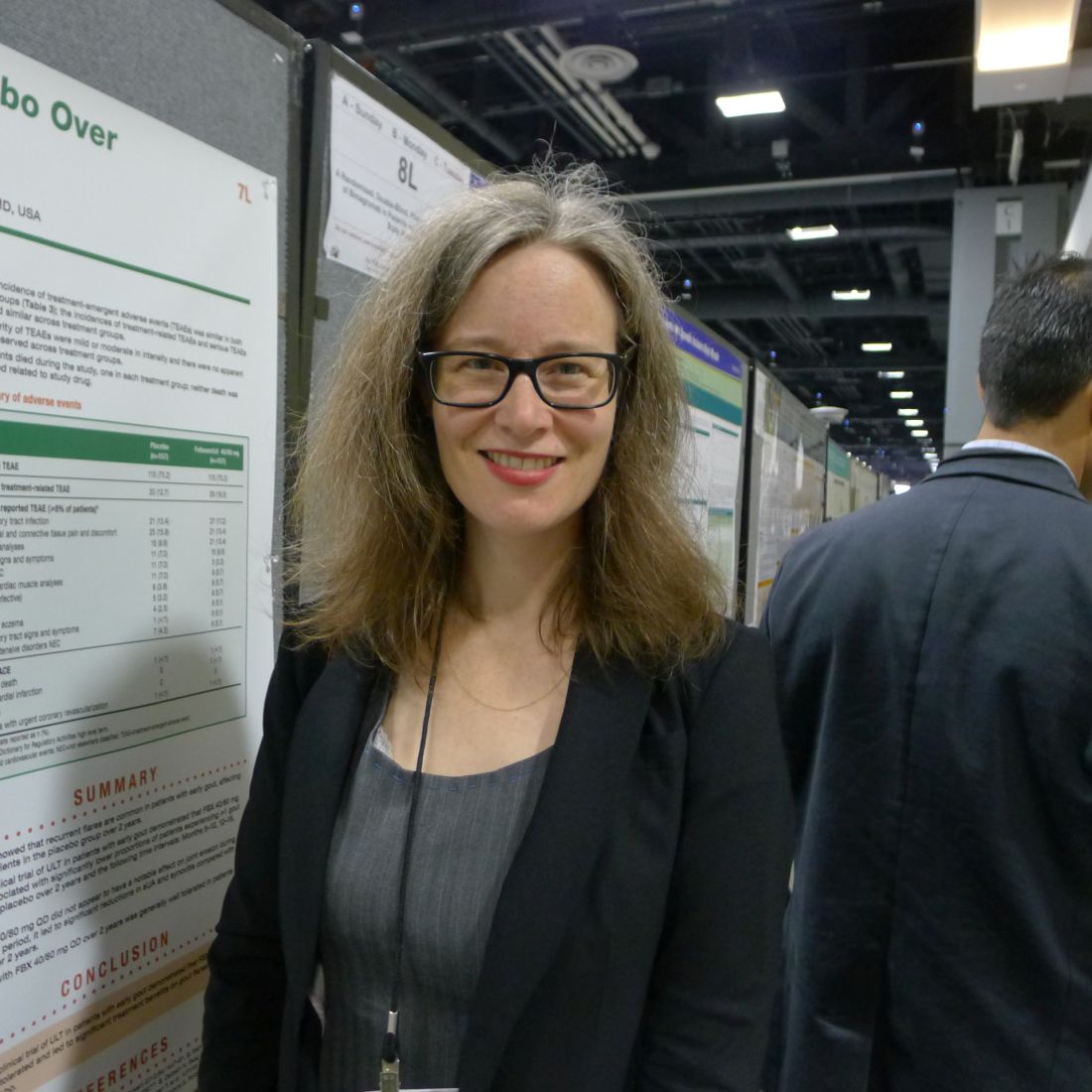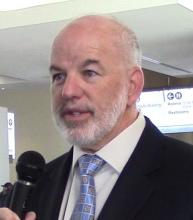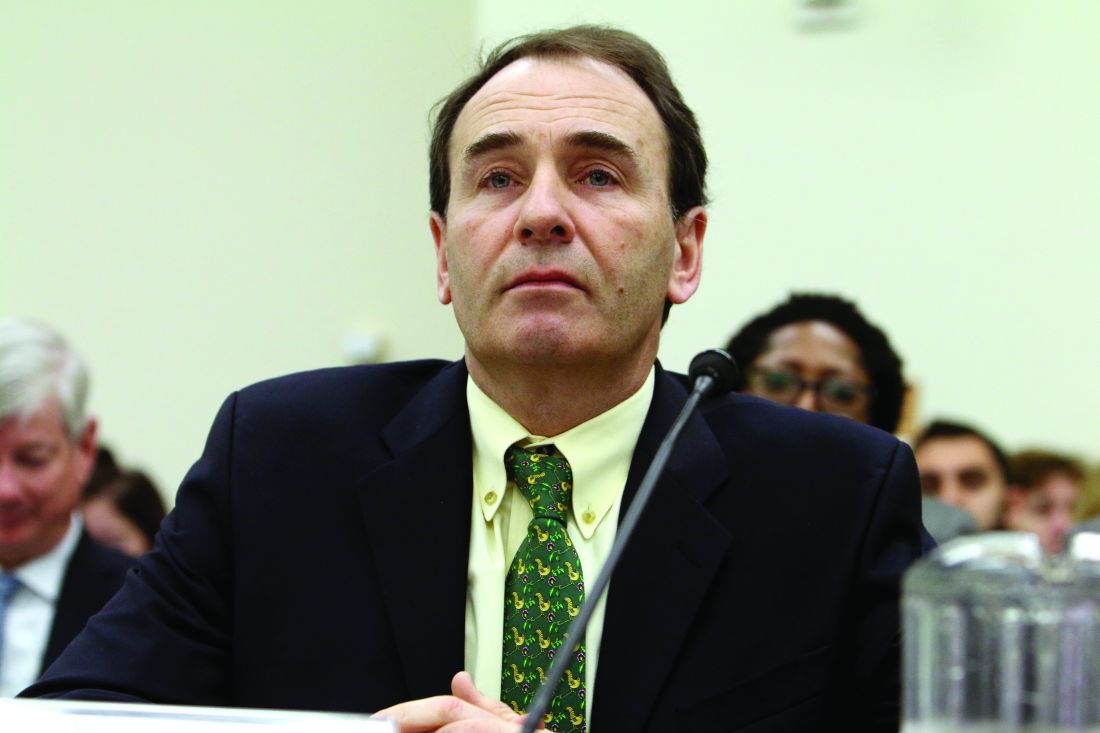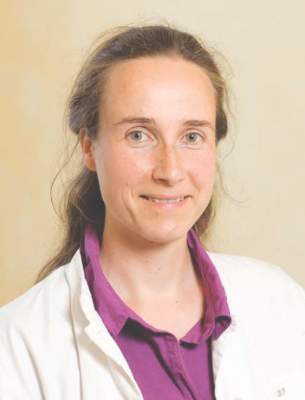User login
Flare risk lower in early-gout patients treated with urate-lowering therapy
WASHINGTON – Putting patients on urate-lowering therapy after their first flare of gout and treating urate levels to target appeared to reduce risk for additional disease flares over a 2-year period, based on results from 314 patients in a randomized, double-blind, placebo-controlled trial.
Among patients with early gout – those experiencing their first gout flare or a second flare that occurred more than 1 year after their first flare – the risk for one or more gout flares during the course of the study was 41% in the placebo group and 29% in the group of patients given febuxostat, a statistically significant difference (P = .033).
The significant advantage for active therapy to prevent flares was seen at 6-12 months, 12-18 months, and 18-24 months.
“The reduction in flares with febuxostat is clinically important and statistically significant,” said lead author Nicola Dalbeth, MD, of the University of Auckland (New Zealand). “This is the first clinical trial of [urate-lowering therapy] in patients with early gout. These are patients who would not be treated under current [American College of Rheumatology] guidelines,” which call for urate-lowering therapy if patients are symptomatic and have experienced two or more flares per year.
Dr. Dalbeth presented the study results at a late-breaker session during the annual meeting of the American College of Rheumatology.
The 314 patients were initially randomized to febuxostat 40 mg or placebo. The febuxostat dosage was increased to 80 mg if serum uric acid levels were above target on day 14, and 60 patients had their febuxostat doses increased.
The study was completed by 57% of placebo patients and 59% of febuxostat patients. Baseline characteristics were similar across treatment arms. Mean baseline serum uric acid was about 8.7 mg/dL, mean age was around 50 years, and more than three-quarters of study participants were white. Mean body-mass index was about 32.5, and mild renal impairment was present in 73% of placebo patients and 67% of febuxostat-treated patients.
Based on imaging studies, febuxostat had no significant effect on joint erosion during the observation period, but it reduced synovitis, compared with placebo, she said.
Dr. Dalbeth disclosed relationships with a variety of drug companies, including serving as a consultant for Takeda, the maker of febuxostat (Uloric).
WASHINGTON – Putting patients on urate-lowering therapy after their first flare of gout and treating urate levels to target appeared to reduce risk for additional disease flares over a 2-year period, based on results from 314 patients in a randomized, double-blind, placebo-controlled trial.
Among patients with early gout – those experiencing their first gout flare or a second flare that occurred more than 1 year after their first flare – the risk for one or more gout flares during the course of the study was 41% in the placebo group and 29% in the group of patients given febuxostat, a statistically significant difference (P = .033).
The significant advantage for active therapy to prevent flares was seen at 6-12 months, 12-18 months, and 18-24 months.
“The reduction in flares with febuxostat is clinically important and statistically significant,” said lead author Nicola Dalbeth, MD, of the University of Auckland (New Zealand). “This is the first clinical trial of [urate-lowering therapy] in patients with early gout. These are patients who would not be treated under current [American College of Rheumatology] guidelines,” which call for urate-lowering therapy if patients are symptomatic and have experienced two or more flares per year.
Dr. Dalbeth presented the study results at a late-breaker session during the annual meeting of the American College of Rheumatology.
The 314 patients were initially randomized to febuxostat 40 mg or placebo. The febuxostat dosage was increased to 80 mg if serum uric acid levels were above target on day 14, and 60 patients had their febuxostat doses increased.
The study was completed by 57% of placebo patients and 59% of febuxostat patients. Baseline characteristics were similar across treatment arms. Mean baseline serum uric acid was about 8.7 mg/dL, mean age was around 50 years, and more than three-quarters of study participants were white. Mean body-mass index was about 32.5, and mild renal impairment was present in 73% of placebo patients and 67% of febuxostat-treated patients.
Based on imaging studies, febuxostat had no significant effect on joint erosion during the observation period, but it reduced synovitis, compared with placebo, she said.
Dr. Dalbeth disclosed relationships with a variety of drug companies, including serving as a consultant for Takeda, the maker of febuxostat (Uloric).
WASHINGTON – Putting patients on urate-lowering therapy after their first flare of gout and treating urate levels to target appeared to reduce risk for additional disease flares over a 2-year period, based on results from 314 patients in a randomized, double-blind, placebo-controlled trial.
Among patients with early gout – those experiencing their first gout flare or a second flare that occurred more than 1 year after their first flare – the risk for one or more gout flares during the course of the study was 41% in the placebo group and 29% in the group of patients given febuxostat, a statistically significant difference (P = .033).
The significant advantage for active therapy to prevent flares was seen at 6-12 months, 12-18 months, and 18-24 months.
“The reduction in flares with febuxostat is clinically important and statistically significant,” said lead author Nicola Dalbeth, MD, of the University of Auckland (New Zealand). “This is the first clinical trial of [urate-lowering therapy] in patients with early gout. These are patients who would not be treated under current [American College of Rheumatology] guidelines,” which call for urate-lowering therapy if patients are symptomatic and have experienced two or more flares per year.
Dr. Dalbeth presented the study results at a late-breaker session during the annual meeting of the American College of Rheumatology.
The 314 patients were initially randomized to febuxostat 40 mg or placebo. The febuxostat dosage was increased to 80 mg if serum uric acid levels were above target on day 14, and 60 patients had their febuxostat doses increased.
The study was completed by 57% of placebo patients and 59% of febuxostat patients. Baseline characteristics were similar across treatment arms. Mean baseline serum uric acid was about 8.7 mg/dL, mean age was around 50 years, and more than three-quarters of study participants were white. Mean body-mass index was about 32.5, and mild renal impairment was present in 73% of placebo patients and 67% of febuxostat-treated patients.
Based on imaging studies, febuxostat had no significant effect on joint erosion during the observation period, but it reduced synovitis, compared with placebo, she said.
Dr. Dalbeth disclosed relationships with a variety of drug companies, including serving as a consultant for Takeda, the maker of febuxostat (Uloric).
AT THE ACR ANNUAL MEETING
Key clinical point:
Major finding: Early-gout patients given febuxostat had a 29% risk of a flare and placebo-treated patients had a 41% risk of a flare over 2 years, a significant difference.
Data source: Randomized, double-blind, placebo-controlled, phase II study of 314 patients with early gout.
Disclosures: Dr. Dalbeth disclosed relationships with a variety of drug companies, including serving as a consultant for Takeda, the maker of febuxostat (Uloric).
Urate-lowering therapy poses no harm to kidney function
WASHINGTON – Evidence supporting the renal benefits of urate-lowering therapy in patients with hyperuricemia and gout comes from two separate studies presented at the annual meeting of the American College of Rheumatology.
In the first study, allopurinol did not increase the risk of developing chronic kidney disease (CKD) in newly diagnosed patients with gout and normal or near-normal kidney function. The second study found that urate-lowering therapy (ULT) improved kidney function in patients who already had CKD.
Allopurinol in gout
The study was prompted by the recognition that gout patients are underdiagnosed and undertreated, and even when they have a diagnosis, both patients and primary care physicians who treat the majority of gout patients shy away from ULT.
“Further exacerbating the poor management of gout is the common practice of lowering the dose or stopping allopurinol when a patient with gout begins to have a decline in kidney function, which inevitably adds to the poor control of gout,” Dr. Vargas-Santos explained.
The study was based on electronic health records from the Health Improvement Network (THIN) database that includes patients treated by general practitioners in the United Kingdom. The study enrolled 13,608 patients with newly diagnosed gout and normal kidney function who initiated ULT with allopurinol; these patients were compared with 13,608 gout patients (matched by propensity score) in the THIN database who did not start ULT.
Patients were aged 18-89 years (mean age, 58 years) with incident gout diagnosed between 2000 and 2014 who had at least one contact with a general practitioner within a year of study enrollment. The investigators analyzed the relationship between allopurinol use by gout patients and the development of CKD stage 3 or higher.
At a mean follow-up of 4 years, there was no increased risk of developing CKD stage 3 or higher in the allopurinol users: 1,401 of the allopurinol initiators versus 1,319 of nonusers developed CKD stage 3 or higher. The relative risk of developing CKD stage 3 or higher on allopurinol was 1.05, which was not statistically significant. “Our study shows that there was no risk of harm to the kidney with allopurinol. This suggests that if a patient on gout presents with declining kidney function, it is better to look for other causes and keep the patient on allopurinol to lower serum urate. Accumulating evidence supports this. Doctors have to be less fearful of prescribing allopurinol. Gout patients deserve better,” Dr. Vargas-Santos said.
ULT in CKD
ULT improved kidney function in patients with CKD in a large retrospective study, with the greatest improvement observed in patients with CKD stage 3 and some improvement observed in patients with CKD stage 2. ULT had no benefit in patients with CKD stage 4, suggesting that these patients are too advanced to improve.
The study was conducted from 2008 to 2014 and included 12,751 patients with serum urate levels of greater than 7 mg/dL and CKD stages 2, 3, and 4 at the index date (the first time this test result was reported). Patients were drawn from the Kaiser Permanente database and treated by primary care physicians. Patients were followed for 1 year from the index date. The primary outcome measure was a 30% increase or a 30% decrease in glomerular filtration rate (GFR) from baseline to the last available result.
Of the 12,751 patients, 2,690 were on ULT and 10,061 were not. Goal serum urate (sUA) was achieved in 1,118 (42%) of patients on ULT. Among patients who achieved goal sUA, a 30% improvement in GFR was observed in 17.1% versus 10.4% of patients who did not achieve goal sUA, for an absolute difference of 6.7% (P less than .001).
For patients at goal versus those not at goal, the ratio of improvement was 3.4 and 3.8, respectively.
“This study suggests that patients with CKD should be tested for uric acid independent of whether they have gout or not. Getting to goal is important. Stage 3 CKD is the sweet spot where patients got the most pronounced benefit from urate-lowering therapy,” he said. “Stage 4 CDK is too late.”
The authors of both studies had no relevant financial disclosures to report.
WASHINGTON – Evidence supporting the renal benefits of urate-lowering therapy in patients with hyperuricemia and gout comes from two separate studies presented at the annual meeting of the American College of Rheumatology.
In the first study, allopurinol did not increase the risk of developing chronic kidney disease (CKD) in newly diagnosed patients with gout and normal or near-normal kidney function. The second study found that urate-lowering therapy (ULT) improved kidney function in patients who already had CKD.
Allopurinol in gout
The study was prompted by the recognition that gout patients are underdiagnosed and undertreated, and even when they have a diagnosis, both patients and primary care physicians who treat the majority of gout patients shy away from ULT.
“Further exacerbating the poor management of gout is the common practice of lowering the dose or stopping allopurinol when a patient with gout begins to have a decline in kidney function, which inevitably adds to the poor control of gout,” Dr. Vargas-Santos explained.
The study was based on electronic health records from the Health Improvement Network (THIN) database that includes patients treated by general practitioners in the United Kingdom. The study enrolled 13,608 patients with newly diagnosed gout and normal kidney function who initiated ULT with allopurinol; these patients were compared with 13,608 gout patients (matched by propensity score) in the THIN database who did not start ULT.
Patients were aged 18-89 years (mean age, 58 years) with incident gout diagnosed between 2000 and 2014 who had at least one contact with a general practitioner within a year of study enrollment. The investigators analyzed the relationship between allopurinol use by gout patients and the development of CKD stage 3 or higher.
At a mean follow-up of 4 years, there was no increased risk of developing CKD stage 3 or higher in the allopurinol users: 1,401 of the allopurinol initiators versus 1,319 of nonusers developed CKD stage 3 or higher. The relative risk of developing CKD stage 3 or higher on allopurinol was 1.05, which was not statistically significant. “Our study shows that there was no risk of harm to the kidney with allopurinol. This suggests that if a patient on gout presents with declining kidney function, it is better to look for other causes and keep the patient on allopurinol to lower serum urate. Accumulating evidence supports this. Doctors have to be less fearful of prescribing allopurinol. Gout patients deserve better,” Dr. Vargas-Santos said.
ULT in CKD
ULT improved kidney function in patients with CKD in a large retrospective study, with the greatest improvement observed in patients with CKD stage 3 and some improvement observed in patients with CKD stage 2. ULT had no benefit in patients with CKD stage 4, suggesting that these patients are too advanced to improve.
The study was conducted from 2008 to 2014 and included 12,751 patients with serum urate levels of greater than 7 mg/dL and CKD stages 2, 3, and 4 at the index date (the first time this test result was reported). Patients were drawn from the Kaiser Permanente database and treated by primary care physicians. Patients were followed for 1 year from the index date. The primary outcome measure was a 30% increase or a 30% decrease in glomerular filtration rate (GFR) from baseline to the last available result.
Of the 12,751 patients, 2,690 were on ULT and 10,061 were not. Goal serum urate (sUA) was achieved in 1,118 (42%) of patients on ULT. Among patients who achieved goal sUA, a 30% improvement in GFR was observed in 17.1% versus 10.4% of patients who did not achieve goal sUA, for an absolute difference of 6.7% (P less than .001).
For patients at goal versus those not at goal, the ratio of improvement was 3.4 and 3.8, respectively.
“This study suggests that patients with CKD should be tested for uric acid independent of whether they have gout or not. Getting to goal is important. Stage 3 CKD is the sweet spot where patients got the most pronounced benefit from urate-lowering therapy,” he said. “Stage 4 CDK is too late.”
The authors of both studies had no relevant financial disclosures to report.
WASHINGTON – Evidence supporting the renal benefits of urate-lowering therapy in patients with hyperuricemia and gout comes from two separate studies presented at the annual meeting of the American College of Rheumatology.
In the first study, allopurinol did not increase the risk of developing chronic kidney disease (CKD) in newly diagnosed patients with gout and normal or near-normal kidney function. The second study found that urate-lowering therapy (ULT) improved kidney function in patients who already had CKD.
Allopurinol in gout
The study was prompted by the recognition that gout patients are underdiagnosed and undertreated, and even when they have a diagnosis, both patients and primary care physicians who treat the majority of gout patients shy away from ULT.
“Further exacerbating the poor management of gout is the common practice of lowering the dose or stopping allopurinol when a patient with gout begins to have a decline in kidney function, which inevitably adds to the poor control of gout,” Dr. Vargas-Santos explained.
The study was based on electronic health records from the Health Improvement Network (THIN) database that includes patients treated by general practitioners in the United Kingdom. The study enrolled 13,608 patients with newly diagnosed gout and normal kidney function who initiated ULT with allopurinol; these patients were compared with 13,608 gout patients (matched by propensity score) in the THIN database who did not start ULT.
Patients were aged 18-89 years (mean age, 58 years) with incident gout diagnosed between 2000 and 2014 who had at least one contact with a general practitioner within a year of study enrollment. The investigators analyzed the relationship between allopurinol use by gout patients and the development of CKD stage 3 or higher.
At a mean follow-up of 4 years, there was no increased risk of developing CKD stage 3 or higher in the allopurinol users: 1,401 of the allopurinol initiators versus 1,319 of nonusers developed CKD stage 3 or higher. The relative risk of developing CKD stage 3 or higher on allopurinol was 1.05, which was not statistically significant. “Our study shows that there was no risk of harm to the kidney with allopurinol. This suggests that if a patient on gout presents with declining kidney function, it is better to look for other causes and keep the patient on allopurinol to lower serum urate. Accumulating evidence supports this. Doctors have to be less fearful of prescribing allopurinol. Gout patients deserve better,” Dr. Vargas-Santos said.
ULT in CKD
ULT improved kidney function in patients with CKD in a large retrospective study, with the greatest improvement observed in patients with CKD stage 3 and some improvement observed in patients with CKD stage 2. ULT had no benefit in patients with CKD stage 4, suggesting that these patients are too advanced to improve.
The study was conducted from 2008 to 2014 and included 12,751 patients with serum urate levels of greater than 7 mg/dL and CKD stages 2, 3, and 4 at the index date (the first time this test result was reported). Patients were drawn from the Kaiser Permanente database and treated by primary care physicians. Patients were followed for 1 year from the index date. The primary outcome measure was a 30% increase or a 30% decrease in glomerular filtration rate (GFR) from baseline to the last available result.
Of the 12,751 patients, 2,690 were on ULT and 10,061 were not. Goal serum urate (sUA) was achieved in 1,118 (42%) of patients on ULT. Among patients who achieved goal sUA, a 30% improvement in GFR was observed in 17.1% versus 10.4% of patients who did not achieve goal sUA, for an absolute difference of 6.7% (P less than .001).
For patients at goal versus those not at goal, the ratio of improvement was 3.4 and 3.8, respectively.
“This study suggests that patients with CKD should be tested for uric acid independent of whether they have gout or not. Getting to goal is important. Stage 3 CKD is the sweet spot where patients got the most pronounced benefit from urate-lowering therapy,” he said. “Stage 4 CDK is too late.”
The authors of both studies had no relevant financial disclosures to report.
AT THE ACR ANNUAL MEETING
Key clinical point:
Major finding: The first study found that allopurinol did not increase the risk of developing CKD stage 3 or higher in gout patients with normal or near-normal kidney function. The second study found that reaching goal with urate-lowering therapy led to improved kidney function, especially in patients with stage 3 CKD.
Data source: Two population-based studies based on the U.K.’s THIN database. The first included 13,608 patients and 13,608 matched controls. The second study included 12,751 patients with serum urate levels of greater than 7 mg/dL.
Disclosures: The authors of both studies had no relevant financial disclosures to report.
VIDEO: Allopurinol may not raise kidney disease risk in gout
WASHINGTON – Urate-lowering therapy (ULT) with allopurinol does not appear to increase the risk of chronic kidney disease in patients with gout who have normal or near-normal kidney function at diagnosis, according to a large retrospective study presented at the annual meeting of the American College of Rheumatology.
The study was based on electronic health records from The Health Improvement Network (THIN), a database that includes patients treated by general practitioners in the United Kingdom.
“It is sad in my practice to see how many gout patients are not treated with ULT because patients fear the side effects of medication or just don’t want to be treated, especially when they are not in flare. Many general practitioners also don’t view gout as a serious condition requiring medication,” said lead author Ana Beatriz Vargas-Santos, PhD, a research fellow at Boston University and a rheumatologist at the State University of Rio de Janeiro in a video interview.
The video associated with this article is no longer available on this site. Please view all of our videos on the MDedge YouTube channel
The study enrolled 13,608 patients with newly diagnosed gout and normal kidney function who started ULT)with allopurinol and compared them with 13,608 gout patients in the THIN database who did not start ULT.
At a mean follow-up of 4 years, there was no increased risk of developing chronic kidney disease (CKD) stage 3 or higher in the allopurinol users: 1,401 of the allopurinol initiators versus 1,319 of nonusers developed CKD stage 3 or higher.
“Our study shows that there was no risk of harm to the kidney with allopurinol. This suggests that if a patient on gout presents with declining kidney function, it is better to look for other causes and keep the patient on allopurinol to lower serum urate. Accumulating evidence is in the same direction. Doctors have to be less fearful of prescribing allopurinol. Gout patients deserve better,” Dr. Vargas-Santos stated.
Dr. Vargas-Santos had no financial disclosures.
WASHINGTON – Urate-lowering therapy (ULT) with allopurinol does not appear to increase the risk of chronic kidney disease in patients with gout who have normal or near-normal kidney function at diagnosis, according to a large retrospective study presented at the annual meeting of the American College of Rheumatology.
The study was based on electronic health records from The Health Improvement Network (THIN), a database that includes patients treated by general practitioners in the United Kingdom.
“It is sad in my practice to see how many gout patients are not treated with ULT because patients fear the side effects of medication or just don’t want to be treated, especially when they are not in flare. Many general practitioners also don’t view gout as a serious condition requiring medication,” said lead author Ana Beatriz Vargas-Santos, PhD, a research fellow at Boston University and a rheumatologist at the State University of Rio de Janeiro in a video interview.
The video associated with this article is no longer available on this site. Please view all of our videos on the MDedge YouTube channel
The study enrolled 13,608 patients with newly diagnosed gout and normal kidney function who started ULT)with allopurinol and compared them with 13,608 gout patients in the THIN database who did not start ULT.
At a mean follow-up of 4 years, there was no increased risk of developing chronic kidney disease (CKD) stage 3 or higher in the allopurinol users: 1,401 of the allopurinol initiators versus 1,319 of nonusers developed CKD stage 3 or higher.
“Our study shows that there was no risk of harm to the kidney with allopurinol. This suggests that if a patient on gout presents with declining kidney function, it is better to look for other causes and keep the patient on allopurinol to lower serum urate. Accumulating evidence is in the same direction. Doctors have to be less fearful of prescribing allopurinol. Gout patients deserve better,” Dr. Vargas-Santos stated.
Dr. Vargas-Santos had no financial disclosures.
WASHINGTON – Urate-lowering therapy (ULT) with allopurinol does not appear to increase the risk of chronic kidney disease in patients with gout who have normal or near-normal kidney function at diagnosis, according to a large retrospective study presented at the annual meeting of the American College of Rheumatology.
The study was based on electronic health records from The Health Improvement Network (THIN), a database that includes patients treated by general practitioners in the United Kingdom.
“It is sad in my practice to see how many gout patients are not treated with ULT because patients fear the side effects of medication or just don’t want to be treated, especially when they are not in flare. Many general practitioners also don’t view gout as a serious condition requiring medication,” said lead author Ana Beatriz Vargas-Santos, PhD, a research fellow at Boston University and a rheumatologist at the State University of Rio de Janeiro in a video interview.
The video associated with this article is no longer available on this site. Please view all of our videos on the MDedge YouTube channel
The study enrolled 13,608 patients with newly diagnosed gout and normal kidney function who started ULT)with allopurinol and compared them with 13,608 gout patients in the THIN database who did not start ULT.
At a mean follow-up of 4 years, there was no increased risk of developing chronic kidney disease (CKD) stage 3 or higher in the allopurinol users: 1,401 of the allopurinol initiators versus 1,319 of nonusers developed CKD stage 3 or higher.
“Our study shows that there was no risk of harm to the kidney with allopurinol. This suggests that if a patient on gout presents with declining kidney function, it is better to look for other causes and keep the patient on allopurinol to lower serum urate. Accumulating evidence is in the same direction. Doctors have to be less fearful of prescribing allopurinol. Gout patients deserve better,” Dr. Vargas-Santos stated.
Dr. Vargas-Santos had no financial disclosures.
AT THE ACR ANNUAL MEETING
ACP on gout: Treat to symptoms, not to urate targets
New gout treatment guidelines support the use of urate-lowering therapy, but find no place for treating patients to achieve any specific serum urate target – a dichotomy that has some rheumatologists scratching their heads.
Created by the American College of Physicians, the gout diagnosis and treatment guideline doesn’t recommend monitoring physiologic response to urate-lowering therapy or treating to specific serum urate target (Ann Int Med. 2016 Nov 1. doi: 10.7326/M16-0570). Instead, it says patients should be treated according to their symptomatic response – a recommendation that flies in the face of accepted clinical practice.
“When we step back and ask the question, ‘Has a randomized, controlled trial looked at this approach?’ The answer is simply no. And we are not willing to take that leap of faith without data.”
Reliance on lower-grade clinical evidence is simply no longer a strong-enough basis for a clinical practice recommendation, Dr. McLean said in an interview. In 2011, the Institute of Medicine raised the bar for guidelines evidence in its report, “Finding What Works in Health Care: Standards for Systematic Reviews.”
That report explicitly states that a clinical guideline cannot be driven by low-grade evidence, including meta-analysis and expert opinion, Dr. McLean said. The Agency for Healthcare Research and Quality National Guideline Clearinghouse incorporated this into its 2013 revision of guidelines acceptance policy: A review must be based on the highest level of evidence – randomized, controlled studies – and not be driven by expert opinion or review articles. Additionally, the literature reviews upon which guidelines are based must be published in a peer-reviewed journal. Guidelines that don’t meet these criteria will no longer be accepted into the clearinghouse.
“The 2012 ACR guidelines didn’t meet that criteria,” he said. “The authors clearly point out in their methodology section where the evidence is weak and admit that 80% of it is low grade. How can you make a guideline that is 80% based on weak evidence? The ACP doesn’t allow us to do that.”
The argument about whether or not to treat to a specific urate target is not simply philosophical, said Dr. McLean, who authored an accompanying editorial (Ann Int Med. 2016 Nov 1. doi: 10.7326/M16-2401). In it, he argued that treating to a prespecified target would certainly help some patients but would probably hurt others.
“Treating to a target necessarily means increasing doses of medication in patients who may be asymptomatic,” he wrote. “Examples exist from other studies using intermediary biomarkers (such as elevated blood pressure or blood glucose level or low hemoglobin level), in which treating to a target resulted in more adverse effects than benefits. Thus, despite the strong biologic appeal of such a strategy and its advocacy by major specialty society guidelines, we judged the strength of evidence for monitoring to be low.”
“This paradigm also has not been formally tested in a randomized clinical trial, and there’s no scientific evidence to support that strategy and a lot of evidence to show its harm,” she said in an interview. “We have a large clinical experience about the ineffectiveness of that strategy. Patients eventually develop tophi, joint damage, and functional limitations when their physicians only treat their gout flares using anti-inflammatory therapy without addressing their underlying cause of gout – high uric acid. They are often dismayed and upset when they realize their physician had let their gout get to that point by just treating their gout flares.”
In other important ways, the two documents are complementary. Both put NSAIDs, corticosteroids, and colchicine at the heart of treating acute gout attacks.
According to the ACP guideline, these treatment strategies are all supported by high-level evidence, which was drawn from a review of 28 studies.
• Corticosteroids, NSAIDs, and colchicine are effective treatments to reduce pain in patients with acute gout.
• Lower doses of colchicine (1.2 mg, followed by 0.6 mg 1 hour later) are as effective as higher doses (1.2 mg, followed by 0.6 mg/hour for 6 hours) at reducing pain and are associated with fewer gastrointestinal adverse effects.
• Do not initiate long-term uric acid–lowering therapy in most patients after a first gout attack or in patients with infrequent attacks.
• Although evidence supports the benefits of using uric acid–lowering therapy for shorter durations to reduce gout flares, the benefits of long-term use in patients with a single or infrequent gout attacks have not been studied.
• Clinicians should discuss benefits, harms, costs, and individual preferences with patients before initiating uric acid–lowering therapy, including concomitant prophylaxis, in patients with recurrent gout attacks. (Grade: strong recommendation, moderate-quality evidence).
• Febuxostat (40 mg/day) and allopurinol (300 mg/day) are equally effective at decreasing serum urate levels, and prophylactic therapy with low-dose colchicine or low-dose NSAIDs reduces the risk for acute gout attacks in patients initiating urate-lowering therapy.
Allopurinol dosage, however, is one key point upon which the ACP and ACR guidelines are sharply divided. The ACR guideline calls for starting at low doses – 100 mg/day, and even lower in patients with kidney disease – with very slow upward titration, only if necessary, to 300 mg/day or more. Allopurinol is not without risk and should be used with caution, Dr. Neogi wrote in her commentary.
“Continuing a management strategy of starting allopurinol at an inappropriately high dose will perpetuate the problem of unnecessarily increasing flare risk, because this risk in the early treatment phase is directly proportional to the potency of the urate-lowering therapy used.”
However, allopurinol doses of 300 mg/day or less leave more than half of all patients undertreated, she said. This dilemma points up the difficulty with symptomatic treatment. Without checking urate levels, clinicians may be shooting blind when trying to dose appropriately.
She refuted any suggestion that the ACR guidelines were based on a lesser degree of evidence than the ACP document.
“The ACR uses a rigorous evidence-based method to develop treatment guidelines. It is inaccurate to say that ACR relies on lower-class evidence or expert opinion ‘to a large extent.’ In the absence of randomized controlled data, other peer-reviewed, available published data are used to formulate guidance, supported by the known biology.”
Current practices outlined in the ACR document are based on a thorough understanding of the biology of gout and how it progresses. Hard data on uric acid targets would greatly impact current therapeutic thinking. But in the meantime, there are patients to be treated, Dr. Neogi said.
“Of course, it would be ideal if we had randomized trial data to definitively provide insights, but we don’t have that right now. So does that mean that patients should suffer unnecessarily because we can’t use the remaining existing body of scientific knowledge to guide rational treatment decisions? What if funding agencies never fund such a study – should gout patients remain poorly managed? Should we abandon all scientific knowledge that isn’t randomized trial data and just not treat at all while waiting to see if a randomized trial will ever be funded and conducted?”
Dr. McLean sees the flip side of that coin.
“I think the effect of our guideline will be to help push the need for more explicit evidence in treat to target being the right way to go. But right now there is not enough evidence now to endorse that approach.”
Dr. McLean reports personal fees from Takeda Pharmaceuticals speakers’ bureau before 2015. Dr. Neogi had no financial disclosures.
New gout treatment guidelines support the use of urate-lowering therapy, but find no place for treating patients to achieve any specific serum urate target – a dichotomy that has some rheumatologists scratching their heads.
Created by the American College of Physicians, the gout diagnosis and treatment guideline doesn’t recommend monitoring physiologic response to urate-lowering therapy or treating to specific serum urate target (Ann Int Med. 2016 Nov 1. doi: 10.7326/M16-0570). Instead, it says patients should be treated according to their symptomatic response – a recommendation that flies in the face of accepted clinical practice.
“When we step back and ask the question, ‘Has a randomized, controlled trial looked at this approach?’ The answer is simply no. And we are not willing to take that leap of faith without data.”
Reliance on lower-grade clinical evidence is simply no longer a strong-enough basis for a clinical practice recommendation, Dr. McLean said in an interview. In 2011, the Institute of Medicine raised the bar for guidelines evidence in its report, “Finding What Works in Health Care: Standards for Systematic Reviews.”
That report explicitly states that a clinical guideline cannot be driven by low-grade evidence, including meta-analysis and expert opinion, Dr. McLean said. The Agency for Healthcare Research and Quality National Guideline Clearinghouse incorporated this into its 2013 revision of guidelines acceptance policy: A review must be based on the highest level of evidence – randomized, controlled studies – and not be driven by expert opinion or review articles. Additionally, the literature reviews upon which guidelines are based must be published in a peer-reviewed journal. Guidelines that don’t meet these criteria will no longer be accepted into the clearinghouse.
“The 2012 ACR guidelines didn’t meet that criteria,” he said. “The authors clearly point out in their methodology section where the evidence is weak and admit that 80% of it is low grade. How can you make a guideline that is 80% based on weak evidence? The ACP doesn’t allow us to do that.”
The argument about whether or not to treat to a specific urate target is not simply philosophical, said Dr. McLean, who authored an accompanying editorial (Ann Int Med. 2016 Nov 1. doi: 10.7326/M16-2401). In it, he argued that treating to a prespecified target would certainly help some patients but would probably hurt others.
“Treating to a target necessarily means increasing doses of medication in patients who may be asymptomatic,” he wrote. “Examples exist from other studies using intermediary biomarkers (such as elevated blood pressure or blood glucose level or low hemoglobin level), in which treating to a target resulted in more adverse effects than benefits. Thus, despite the strong biologic appeal of such a strategy and its advocacy by major specialty society guidelines, we judged the strength of evidence for monitoring to be low.”
“This paradigm also has not been formally tested in a randomized clinical trial, and there’s no scientific evidence to support that strategy and a lot of evidence to show its harm,” she said in an interview. “We have a large clinical experience about the ineffectiveness of that strategy. Patients eventually develop tophi, joint damage, and functional limitations when their physicians only treat their gout flares using anti-inflammatory therapy without addressing their underlying cause of gout – high uric acid. They are often dismayed and upset when they realize their physician had let their gout get to that point by just treating their gout flares.”
In other important ways, the two documents are complementary. Both put NSAIDs, corticosteroids, and colchicine at the heart of treating acute gout attacks.
According to the ACP guideline, these treatment strategies are all supported by high-level evidence, which was drawn from a review of 28 studies.
• Corticosteroids, NSAIDs, and colchicine are effective treatments to reduce pain in patients with acute gout.
• Lower doses of colchicine (1.2 mg, followed by 0.6 mg 1 hour later) are as effective as higher doses (1.2 mg, followed by 0.6 mg/hour for 6 hours) at reducing pain and are associated with fewer gastrointestinal adverse effects.
• Do not initiate long-term uric acid–lowering therapy in most patients after a first gout attack or in patients with infrequent attacks.
• Although evidence supports the benefits of using uric acid–lowering therapy for shorter durations to reduce gout flares, the benefits of long-term use in patients with a single or infrequent gout attacks have not been studied.
• Clinicians should discuss benefits, harms, costs, and individual preferences with patients before initiating uric acid–lowering therapy, including concomitant prophylaxis, in patients with recurrent gout attacks. (Grade: strong recommendation, moderate-quality evidence).
• Febuxostat (40 mg/day) and allopurinol (300 mg/day) are equally effective at decreasing serum urate levels, and prophylactic therapy with low-dose colchicine or low-dose NSAIDs reduces the risk for acute gout attacks in patients initiating urate-lowering therapy.
Allopurinol dosage, however, is one key point upon which the ACP and ACR guidelines are sharply divided. The ACR guideline calls for starting at low doses – 100 mg/day, and even lower in patients with kidney disease – with very slow upward titration, only if necessary, to 300 mg/day or more. Allopurinol is not without risk and should be used with caution, Dr. Neogi wrote in her commentary.
“Continuing a management strategy of starting allopurinol at an inappropriately high dose will perpetuate the problem of unnecessarily increasing flare risk, because this risk in the early treatment phase is directly proportional to the potency of the urate-lowering therapy used.”
However, allopurinol doses of 300 mg/day or less leave more than half of all patients undertreated, she said. This dilemma points up the difficulty with symptomatic treatment. Without checking urate levels, clinicians may be shooting blind when trying to dose appropriately.
She refuted any suggestion that the ACR guidelines were based on a lesser degree of evidence than the ACP document.
“The ACR uses a rigorous evidence-based method to develop treatment guidelines. It is inaccurate to say that ACR relies on lower-class evidence or expert opinion ‘to a large extent.’ In the absence of randomized controlled data, other peer-reviewed, available published data are used to formulate guidance, supported by the known biology.”
Current practices outlined in the ACR document are based on a thorough understanding of the biology of gout and how it progresses. Hard data on uric acid targets would greatly impact current therapeutic thinking. But in the meantime, there are patients to be treated, Dr. Neogi said.
“Of course, it would be ideal if we had randomized trial data to definitively provide insights, but we don’t have that right now. So does that mean that patients should suffer unnecessarily because we can’t use the remaining existing body of scientific knowledge to guide rational treatment decisions? What if funding agencies never fund such a study – should gout patients remain poorly managed? Should we abandon all scientific knowledge that isn’t randomized trial data and just not treat at all while waiting to see if a randomized trial will ever be funded and conducted?”
Dr. McLean sees the flip side of that coin.
“I think the effect of our guideline will be to help push the need for more explicit evidence in treat to target being the right way to go. But right now there is not enough evidence now to endorse that approach.”
Dr. McLean reports personal fees from Takeda Pharmaceuticals speakers’ bureau before 2015. Dr. Neogi had no financial disclosures.
New gout treatment guidelines support the use of urate-lowering therapy, but find no place for treating patients to achieve any specific serum urate target – a dichotomy that has some rheumatologists scratching their heads.
Created by the American College of Physicians, the gout diagnosis and treatment guideline doesn’t recommend monitoring physiologic response to urate-lowering therapy or treating to specific serum urate target (Ann Int Med. 2016 Nov 1. doi: 10.7326/M16-0570). Instead, it says patients should be treated according to their symptomatic response – a recommendation that flies in the face of accepted clinical practice.
“When we step back and ask the question, ‘Has a randomized, controlled trial looked at this approach?’ The answer is simply no. And we are not willing to take that leap of faith without data.”
Reliance on lower-grade clinical evidence is simply no longer a strong-enough basis for a clinical practice recommendation, Dr. McLean said in an interview. In 2011, the Institute of Medicine raised the bar for guidelines evidence in its report, “Finding What Works in Health Care: Standards for Systematic Reviews.”
That report explicitly states that a clinical guideline cannot be driven by low-grade evidence, including meta-analysis and expert opinion, Dr. McLean said. The Agency for Healthcare Research and Quality National Guideline Clearinghouse incorporated this into its 2013 revision of guidelines acceptance policy: A review must be based on the highest level of evidence – randomized, controlled studies – and not be driven by expert opinion or review articles. Additionally, the literature reviews upon which guidelines are based must be published in a peer-reviewed journal. Guidelines that don’t meet these criteria will no longer be accepted into the clearinghouse.
“The 2012 ACR guidelines didn’t meet that criteria,” he said. “The authors clearly point out in their methodology section where the evidence is weak and admit that 80% of it is low grade. How can you make a guideline that is 80% based on weak evidence? The ACP doesn’t allow us to do that.”
The argument about whether or not to treat to a specific urate target is not simply philosophical, said Dr. McLean, who authored an accompanying editorial (Ann Int Med. 2016 Nov 1. doi: 10.7326/M16-2401). In it, he argued that treating to a prespecified target would certainly help some patients but would probably hurt others.
“Treating to a target necessarily means increasing doses of medication in patients who may be asymptomatic,” he wrote. “Examples exist from other studies using intermediary biomarkers (such as elevated blood pressure or blood glucose level or low hemoglobin level), in which treating to a target resulted in more adverse effects than benefits. Thus, despite the strong biologic appeal of such a strategy and its advocacy by major specialty society guidelines, we judged the strength of evidence for monitoring to be low.”
“This paradigm also has not been formally tested in a randomized clinical trial, and there’s no scientific evidence to support that strategy and a lot of evidence to show its harm,” she said in an interview. “We have a large clinical experience about the ineffectiveness of that strategy. Patients eventually develop tophi, joint damage, and functional limitations when their physicians only treat their gout flares using anti-inflammatory therapy without addressing their underlying cause of gout – high uric acid. They are often dismayed and upset when they realize their physician had let their gout get to that point by just treating their gout flares.”
In other important ways, the two documents are complementary. Both put NSAIDs, corticosteroids, and colchicine at the heart of treating acute gout attacks.
According to the ACP guideline, these treatment strategies are all supported by high-level evidence, which was drawn from a review of 28 studies.
• Corticosteroids, NSAIDs, and colchicine are effective treatments to reduce pain in patients with acute gout.
• Lower doses of colchicine (1.2 mg, followed by 0.6 mg 1 hour later) are as effective as higher doses (1.2 mg, followed by 0.6 mg/hour for 6 hours) at reducing pain and are associated with fewer gastrointestinal adverse effects.
• Do not initiate long-term uric acid–lowering therapy in most patients after a first gout attack or in patients with infrequent attacks.
• Although evidence supports the benefits of using uric acid–lowering therapy for shorter durations to reduce gout flares, the benefits of long-term use in patients with a single or infrequent gout attacks have not been studied.
• Clinicians should discuss benefits, harms, costs, and individual preferences with patients before initiating uric acid–lowering therapy, including concomitant prophylaxis, in patients with recurrent gout attacks. (Grade: strong recommendation, moderate-quality evidence).
• Febuxostat (40 mg/day) and allopurinol (300 mg/day) are equally effective at decreasing serum urate levels, and prophylactic therapy with low-dose colchicine or low-dose NSAIDs reduces the risk for acute gout attacks in patients initiating urate-lowering therapy.
Allopurinol dosage, however, is one key point upon which the ACP and ACR guidelines are sharply divided. The ACR guideline calls for starting at low doses – 100 mg/day, and even lower in patients with kidney disease – with very slow upward titration, only if necessary, to 300 mg/day or more. Allopurinol is not without risk and should be used with caution, Dr. Neogi wrote in her commentary.
“Continuing a management strategy of starting allopurinol at an inappropriately high dose will perpetuate the problem of unnecessarily increasing flare risk, because this risk in the early treatment phase is directly proportional to the potency of the urate-lowering therapy used.”
However, allopurinol doses of 300 mg/day or less leave more than half of all patients undertreated, she said. This dilemma points up the difficulty with symptomatic treatment. Without checking urate levels, clinicians may be shooting blind when trying to dose appropriately.
She refuted any suggestion that the ACR guidelines were based on a lesser degree of evidence than the ACP document.
“The ACR uses a rigorous evidence-based method to develop treatment guidelines. It is inaccurate to say that ACR relies on lower-class evidence or expert opinion ‘to a large extent.’ In the absence of randomized controlled data, other peer-reviewed, available published data are used to formulate guidance, supported by the known biology.”
Current practices outlined in the ACR document are based on a thorough understanding of the biology of gout and how it progresses. Hard data on uric acid targets would greatly impact current therapeutic thinking. But in the meantime, there are patients to be treated, Dr. Neogi said.
“Of course, it would be ideal if we had randomized trial data to definitively provide insights, but we don’t have that right now. So does that mean that patients should suffer unnecessarily because we can’t use the remaining existing body of scientific knowledge to guide rational treatment decisions? What if funding agencies never fund such a study – should gout patients remain poorly managed? Should we abandon all scientific knowledge that isn’t randomized trial data and just not treat at all while waiting to see if a randomized trial will ever be funded and conducted?”
Dr. McLean sees the flip side of that coin.
“I think the effect of our guideline will be to help push the need for more explicit evidence in treat to target being the right way to go. But right now there is not enough evidence now to endorse that approach.”
Dr. McLean reports personal fees from Takeda Pharmaceuticals speakers’ bureau before 2015. Dr. Neogi had no financial disclosures.
Study provides best support to date for using ultrasound to detect gout
Ultrasound examination of patients with at least one swollen joint or a subcutaneous nodule detected gout with a sensitivity of 76.9% and specificity of 84.3% in an international, multicenter study.
“Ultrasound is a good test for gout,” said study lead author Alexis R. Ogdie-Beatty, MD, of the University of Pennsylvania, Philadelphia. “It has high specificity, even among patients with early disease. The sensitivity was lower so it doesn’t pick up all cases of gout, although it was higher in people with a longer duration of disease.”
But gout remains difficult to diagnose because of the many similar types of inflammatory arthritis. A 2016 report from the Agency for Healthcare Research and Quality says proper diagnosis is a “major challenge,” especially in primary care and urgent/emergency settings.
Monosodium urate (MSU) crystal analysis via joint aspiration is considered the “gold standard” of gout diagnostic tools, but the agency report notes that it “can be technically difficult to perform and painful to the patient.”
There are other challenges. “Sometimes we see people between flares, or it’s already started to improve so there’s not enough fluid to perform an arthrocentesis,” Dr. Ogdie-Beatty said in an interview. “Additionally, while rheumatologists are generally very good at joint aspirations, many primary care physicians are not specifically trained for this. Thus, an imaging study can be helpful in these cases.”
The new study (Arthritis Rheumatol. 2016 Oct 16. doi: 10.1002/art.39959) follows up on findings from the multicenter, cross-sectional Study for Updated Gout Classification Criteria, which independently linked ultrasound analysis to diagnosis of gout with an odds ratio of 7.2 (Arthritis Care Res. 2015 Sep;67[9]:1304-15). One goal of the new study is to determine specificity and sensitivity of ultrasound exams.
The researchers examined data from the previous study, which enrolled consecutive patients in clinical practice settings across 25 countries who had at least one swollen joint or a subcutaneous nodule in whom gout was on the differential diagnosis. They underwent ultrasound examinations (most commonly of the knees, metatarsophalangeal joints, and ankles) and were deemed to have a “positive test” if at least one of three signs appeared: a “double contour” sign, tophus, or a “snowstorm” appearance. However, the study did not require a specific ultrasound scanning protocol or training.
MSU crystal examinations confirmed which of the subjects actually had gout. In total, ultrasound examinations were performed on 824 patients, of whom 416 were confirmed to have gout (mean age, 60, and 87% male), and the other 408 did not have gout (mean age, 60, and 54% male).
The researchers found that the sensitivity of the ultrasound exams was 76.9%, meaning they correctly identified patients with gout just over three-quarters of the time. Dr. Ogdie-Beatty referred to this as “moderate” sensitivity. The researchers found that the sensitivity was highest in patients who’d had disease for 2 or more years and in those who didn’t show clinical signs of tophi.
The specificity for these signs – the percentage of the time that ultrasound exams correctly identified patients without gout – was 84.3%. The positive and negative predictive values were 83.3% and 78.1%, respectively.
Dr. Ogdie-Beatty said the cost of ultrasound examinations is variable, although insurance covers it for trained providers. It’s unclear how commonly ultrasound examinations are used to detect gout, she said, but “many rheumatologists now have ultrasound as a part of their practice, and ultrasound training during fellowship has become important.”
Dr. Ogdie-Beatty reported receiving consulting fees from Novartis, and her coauthors reported various financial relationships with industry. The study was supported by various National Institutes of Health grants to several authors, as well as the American College of Rheumatology, the European League Against Rheumatism, and various arthritis-related organizations.
The new study provides evidence that both answers and raises questions about the technical standards by which musculoskeletal ultrasound examination is used to detect gout and about what we mean when we make a clinical diagnosis of gout.
The study’s results showed that ultrasound provided excellent specificity for gout in the setting of acute calcium pyrophosphate deposition disease (CPPD), also known as pseudogout, particularly in distinguishing the deposition of monosodium urate on the surface of cartilage (double contour sign), and calcium pyrophosphate within the matrix of the cartilage (interface sign). Ultrasound’s specificity for gout apart from CPPD was particularly high when more than one feature of gout was present because one feature of gout was more often present in patients with CPPD than in non-CPPD controls, but this was not the case when two features of gout were present. However, this leaves open the possibility that some patients may concurrently have both CPPD and gout, which the study does not fully address. Apart from the level of operator experience in using ultrasound, diagnostic bias did not seem to play a role in the diagnostic utility of ultrasound because clinical appearance of scanned joints or presence of tophi did not greatly affect its sensitivity when considering that patients with tophi have more advanced disease and probably have more obvious ultrasound findings.
The study’s demonstration of ultrasound’s ability to identify tophi is important because rheumatologists consider the presence of tophi as marking the transition from hyperuricemia to gout, which often involves of inflammation and tissue damage. Many other studies have noted how people with hyperuricemia can have the double contour sign without meeting clinical criteria for gout.
It still remains important to note that, even though the test characteristics of ultrasound in the study should be generalizable, its ability to support a diagnosis of acute gout does not rule out infection in the same joint.
Eugene Y. Kissin, MD, is with the division of rheumatology at Boston University, and Michael H. Pillinger, MD, is with the division of rheumatology at New York University, New York. Their comments are derived from their editorial accompanying the study by Dr. Ogdie-Beatty and her colleagues (Arthritis Rheumatol. 2016 Oct 16. doi: 10.1002/art.39958). Dr. Kissin reported no disclosures. Dr. Pillinger reported consulting for AstraZeneca, Crealta/Horizon, and Sobi, and he has served as an investigator for a trial sponsored by Takeda.
The new study provides evidence that both answers and raises questions about the technical standards by which musculoskeletal ultrasound examination is used to detect gout and about what we mean when we make a clinical diagnosis of gout.
The study’s results showed that ultrasound provided excellent specificity for gout in the setting of acute calcium pyrophosphate deposition disease (CPPD), also known as pseudogout, particularly in distinguishing the deposition of monosodium urate on the surface of cartilage (double contour sign), and calcium pyrophosphate within the matrix of the cartilage (interface sign). Ultrasound’s specificity for gout apart from CPPD was particularly high when more than one feature of gout was present because one feature of gout was more often present in patients with CPPD than in non-CPPD controls, but this was not the case when two features of gout were present. However, this leaves open the possibility that some patients may concurrently have both CPPD and gout, which the study does not fully address. Apart from the level of operator experience in using ultrasound, diagnostic bias did not seem to play a role in the diagnostic utility of ultrasound because clinical appearance of scanned joints or presence of tophi did not greatly affect its sensitivity when considering that patients with tophi have more advanced disease and probably have more obvious ultrasound findings.
The study’s demonstration of ultrasound’s ability to identify tophi is important because rheumatologists consider the presence of tophi as marking the transition from hyperuricemia to gout, which often involves of inflammation and tissue damage. Many other studies have noted how people with hyperuricemia can have the double contour sign without meeting clinical criteria for gout.
It still remains important to note that, even though the test characteristics of ultrasound in the study should be generalizable, its ability to support a diagnosis of acute gout does not rule out infection in the same joint.
Eugene Y. Kissin, MD, is with the division of rheumatology at Boston University, and Michael H. Pillinger, MD, is with the division of rheumatology at New York University, New York. Their comments are derived from their editorial accompanying the study by Dr. Ogdie-Beatty and her colleagues (Arthritis Rheumatol. 2016 Oct 16. doi: 10.1002/art.39958). Dr. Kissin reported no disclosures. Dr. Pillinger reported consulting for AstraZeneca, Crealta/Horizon, and Sobi, and he has served as an investigator for a trial sponsored by Takeda.
The new study provides evidence that both answers and raises questions about the technical standards by which musculoskeletal ultrasound examination is used to detect gout and about what we mean when we make a clinical diagnosis of gout.
The study’s results showed that ultrasound provided excellent specificity for gout in the setting of acute calcium pyrophosphate deposition disease (CPPD), also known as pseudogout, particularly in distinguishing the deposition of monosodium urate on the surface of cartilage (double contour sign), and calcium pyrophosphate within the matrix of the cartilage (interface sign). Ultrasound’s specificity for gout apart from CPPD was particularly high when more than one feature of gout was present because one feature of gout was more often present in patients with CPPD than in non-CPPD controls, but this was not the case when two features of gout were present. However, this leaves open the possibility that some patients may concurrently have both CPPD and gout, which the study does not fully address. Apart from the level of operator experience in using ultrasound, diagnostic bias did not seem to play a role in the diagnostic utility of ultrasound because clinical appearance of scanned joints or presence of tophi did not greatly affect its sensitivity when considering that patients with tophi have more advanced disease and probably have more obvious ultrasound findings.
The study’s demonstration of ultrasound’s ability to identify tophi is important because rheumatologists consider the presence of tophi as marking the transition from hyperuricemia to gout, which often involves of inflammation and tissue damage. Many other studies have noted how people with hyperuricemia can have the double contour sign without meeting clinical criteria for gout.
It still remains important to note that, even though the test characteristics of ultrasound in the study should be generalizable, its ability to support a diagnosis of acute gout does not rule out infection in the same joint.
Eugene Y. Kissin, MD, is with the division of rheumatology at Boston University, and Michael H. Pillinger, MD, is with the division of rheumatology at New York University, New York. Their comments are derived from their editorial accompanying the study by Dr. Ogdie-Beatty and her colleagues (Arthritis Rheumatol. 2016 Oct 16. doi: 10.1002/art.39958). Dr. Kissin reported no disclosures. Dr. Pillinger reported consulting for AstraZeneca, Crealta/Horizon, and Sobi, and he has served as an investigator for a trial sponsored by Takeda.
Ultrasound examination of patients with at least one swollen joint or a subcutaneous nodule detected gout with a sensitivity of 76.9% and specificity of 84.3% in an international, multicenter study.
“Ultrasound is a good test for gout,” said study lead author Alexis R. Ogdie-Beatty, MD, of the University of Pennsylvania, Philadelphia. “It has high specificity, even among patients with early disease. The sensitivity was lower so it doesn’t pick up all cases of gout, although it was higher in people with a longer duration of disease.”
But gout remains difficult to diagnose because of the many similar types of inflammatory arthritis. A 2016 report from the Agency for Healthcare Research and Quality says proper diagnosis is a “major challenge,” especially in primary care and urgent/emergency settings.
Monosodium urate (MSU) crystal analysis via joint aspiration is considered the “gold standard” of gout diagnostic tools, but the agency report notes that it “can be technically difficult to perform and painful to the patient.”
There are other challenges. “Sometimes we see people between flares, or it’s already started to improve so there’s not enough fluid to perform an arthrocentesis,” Dr. Ogdie-Beatty said in an interview. “Additionally, while rheumatologists are generally very good at joint aspirations, many primary care physicians are not specifically trained for this. Thus, an imaging study can be helpful in these cases.”
The new study (Arthritis Rheumatol. 2016 Oct 16. doi: 10.1002/art.39959) follows up on findings from the multicenter, cross-sectional Study for Updated Gout Classification Criteria, which independently linked ultrasound analysis to diagnosis of gout with an odds ratio of 7.2 (Arthritis Care Res. 2015 Sep;67[9]:1304-15). One goal of the new study is to determine specificity and sensitivity of ultrasound exams.
The researchers examined data from the previous study, which enrolled consecutive patients in clinical practice settings across 25 countries who had at least one swollen joint or a subcutaneous nodule in whom gout was on the differential diagnosis. They underwent ultrasound examinations (most commonly of the knees, metatarsophalangeal joints, and ankles) and were deemed to have a “positive test” if at least one of three signs appeared: a “double contour” sign, tophus, or a “snowstorm” appearance. However, the study did not require a specific ultrasound scanning protocol or training.
MSU crystal examinations confirmed which of the subjects actually had gout. In total, ultrasound examinations were performed on 824 patients, of whom 416 were confirmed to have gout (mean age, 60, and 87% male), and the other 408 did not have gout (mean age, 60, and 54% male).
The researchers found that the sensitivity of the ultrasound exams was 76.9%, meaning they correctly identified patients with gout just over three-quarters of the time. Dr. Ogdie-Beatty referred to this as “moderate” sensitivity. The researchers found that the sensitivity was highest in patients who’d had disease for 2 or more years and in those who didn’t show clinical signs of tophi.
The specificity for these signs – the percentage of the time that ultrasound exams correctly identified patients without gout – was 84.3%. The positive and negative predictive values were 83.3% and 78.1%, respectively.
Dr. Ogdie-Beatty said the cost of ultrasound examinations is variable, although insurance covers it for trained providers. It’s unclear how commonly ultrasound examinations are used to detect gout, she said, but “many rheumatologists now have ultrasound as a part of their practice, and ultrasound training during fellowship has become important.”
Dr. Ogdie-Beatty reported receiving consulting fees from Novartis, and her coauthors reported various financial relationships with industry. The study was supported by various National Institutes of Health grants to several authors, as well as the American College of Rheumatology, the European League Against Rheumatism, and various arthritis-related organizations.
Ultrasound examination of patients with at least one swollen joint or a subcutaneous nodule detected gout with a sensitivity of 76.9% and specificity of 84.3% in an international, multicenter study.
“Ultrasound is a good test for gout,” said study lead author Alexis R. Ogdie-Beatty, MD, of the University of Pennsylvania, Philadelphia. “It has high specificity, even among patients with early disease. The sensitivity was lower so it doesn’t pick up all cases of gout, although it was higher in people with a longer duration of disease.”
But gout remains difficult to diagnose because of the many similar types of inflammatory arthritis. A 2016 report from the Agency for Healthcare Research and Quality says proper diagnosis is a “major challenge,” especially in primary care and urgent/emergency settings.
Monosodium urate (MSU) crystal analysis via joint aspiration is considered the “gold standard” of gout diagnostic tools, but the agency report notes that it “can be technically difficult to perform and painful to the patient.”
There are other challenges. “Sometimes we see people between flares, or it’s already started to improve so there’s not enough fluid to perform an arthrocentesis,” Dr. Ogdie-Beatty said in an interview. “Additionally, while rheumatologists are generally very good at joint aspirations, many primary care physicians are not specifically trained for this. Thus, an imaging study can be helpful in these cases.”
The new study (Arthritis Rheumatol. 2016 Oct 16. doi: 10.1002/art.39959) follows up on findings from the multicenter, cross-sectional Study for Updated Gout Classification Criteria, which independently linked ultrasound analysis to diagnosis of gout with an odds ratio of 7.2 (Arthritis Care Res. 2015 Sep;67[9]:1304-15). One goal of the new study is to determine specificity and sensitivity of ultrasound exams.
The researchers examined data from the previous study, which enrolled consecutive patients in clinical practice settings across 25 countries who had at least one swollen joint or a subcutaneous nodule in whom gout was on the differential diagnosis. They underwent ultrasound examinations (most commonly of the knees, metatarsophalangeal joints, and ankles) and were deemed to have a “positive test” if at least one of three signs appeared: a “double contour” sign, tophus, or a “snowstorm” appearance. However, the study did not require a specific ultrasound scanning protocol or training.
MSU crystal examinations confirmed which of the subjects actually had gout. In total, ultrasound examinations were performed on 824 patients, of whom 416 were confirmed to have gout (mean age, 60, and 87% male), and the other 408 did not have gout (mean age, 60, and 54% male).
The researchers found that the sensitivity of the ultrasound exams was 76.9%, meaning they correctly identified patients with gout just over three-quarters of the time. Dr. Ogdie-Beatty referred to this as “moderate” sensitivity. The researchers found that the sensitivity was highest in patients who’d had disease for 2 or more years and in those who didn’t show clinical signs of tophi.
The specificity for these signs – the percentage of the time that ultrasound exams correctly identified patients without gout – was 84.3%. The positive and negative predictive values were 83.3% and 78.1%, respectively.
Dr. Ogdie-Beatty said the cost of ultrasound examinations is variable, although insurance covers it for trained providers. It’s unclear how commonly ultrasound examinations are used to detect gout, she said, but “many rheumatologists now have ultrasound as a part of their practice, and ultrasound training during fellowship has become important.”
Dr. Ogdie-Beatty reported receiving consulting fees from Novartis, and her coauthors reported various financial relationships with industry. The study was supported by various National Institutes of Health grants to several authors, as well as the American College of Rheumatology, the European League Against Rheumatism, and various arthritis-related organizations.
FROM ARTHRITIS & RHEUMATOLOGY
Key clinical point:
Major finding: Examiners looked for at least one of three potential signs of gout. The sensitivity for gout was 76.9%, and the specificity was 84.3%.
Data source: 824 patients with potential signs of gout who underwent ultrasound examination in an international, multicenter, observational cross-sectional study
Disclosures: Dr. Ogdie-Beatty reported receiving consulting fees from Novartis, and her coauthors reported various financial relationships with industry. The study was supported by various National Institutes of Health grants to several authors, as well as the American College of Rheumatology, the European League Against Rheumatism, and various arthritis-related organizations.
Severe joint pain in adults with arthritis continues to rise
The prevalence of severe joint pain among adults with diagnosed arthritis continues to increase, researchers from the Centers for Disease Control and Prevention reported in the Oct. 7 Morbidity and Mortality Weekly Report.
In 2014, more than one-fourth of adults with arthritis had severe joint pain. That is about 14.6 million Americans with severe joint pain, a significant increase from 2002 when there were an estimated 10.5 million adults with severe joint pain, according to Kamil E. Barbour, PhD, and his associates from the National Center for Chronic Disease Prevention and Health Promotion (MMWR. 2016 Oct 7;65[39]:1052-6).
Severe joint pain was also more prevalent among patients with overall fair or poor health who were obese or had heart disease, diabetes, or serious psychological distress, the investigators reported.
The investigators defined people with arthritis as those who had “been told by a doctor or other health professional” that they have some form of arthritis, rheumatoid arthritis, gout, lupus, or fibromyalgia. Severe joint pain was defined as a response of 7 or higher on a scale of 0-10 for rating joint pain on average over the past 30 days.
Recently, the U.S. Department of Health & Human Services released its National Pain Strategy, the nation’s first broad, federal effort aimed at developing strategies to reduce the burden of pain among Americans. The initiatives major objectives are to take steps to reduce barriers to pain care, and to increase patient knowledge of treatment options and risks, Dr. Barbour and his associates wrote.
“Health care providers and public health practitioners can begin to implement the recommendations [from the National Pain Strategy] and improve pain care among adults with arthritis and [severe joint pain] by prioritizing self-management education and appropriate physical activity interventions as effective nonpharmacologic ways to reduce pain and improve health outcomes,” the researchers added.
[email protected]
On Twitter @jessnicolecraig
The prevalence of severe joint pain among adults with diagnosed arthritis continues to increase, researchers from the Centers for Disease Control and Prevention reported in the Oct. 7 Morbidity and Mortality Weekly Report.
In 2014, more than one-fourth of adults with arthritis had severe joint pain. That is about 14.6 million Americans with severe joint pain, a significant increase from 2002 when there were an estimated 10.5 million adults with severe joint pain, according to Kamil E. Barbour, PhD, and his associates from the National Center for Chronic Disease Prevention and Health Promotion (MMWR. 2016 Oct 7;65[39]:1052-6).
Severe joint pain was also more prevalent among patients with overall fair or poor health who were obese or had heart disease, diabetes, or serious psychological distress, the investigators reported.
The investigators defined people with arthritis as those who had “been told by a doctor or other health professional” that they have some form of arthritis, rheumatoid arthritis, gout, lupus, or fibromyalgia. Severe joint pain was defined as a response of 7 or higher on a scale of 0-10 for rating joint pain on average over the past 30 days.
Recently, the U.S. Department of Health & Human Services released its National Pain Strategy, the nation’s first broad, federal effort aimed at developing strategies to reduce the burden of pain among Americans. The initiatives major objectives are to take steps to reduce barriers to pain care, and to increase patient knowledge of treatment options and risks, Dr. Barbour and his associates wrote.
“Health care providers and public health practitioners can begin to implement the recommendations [from the National Pain Strategy] and improve pain care among adults with arthritis and [severe joint pain] by prioritizing self-management education and appropriate physical activity interventions as effective nonpharmacologic ways to reduce pain and improve health outcomes,” the researchers added.
[email protected]
On Twitter @jessnicolecraig
The prevalence of severe joint pain among adults with diagnosed arthritis continues to increase, researchers from the Centers for Disease Control and Prevention reported in the Oct. 7 Morbidity and Mortality Weekly Report.
In 2014, more than one-fourth of adults with arthritis had severe joint pain. That is about 14.6 million Americans with severe joint pain, a significant increase from 2002 when there were an estimated 10.5 million adults with severe joint pain, according to Kamil E. Barbour, PhD, and his associates from the National Center for Chronic Disease Prevention and Health Promotion (MMWR. 2016 Oct 7;65[39]:1052-6).
Severe joint pain was also more prevalent among patients with overall fair or poor health who were obese or had heart disease, diabetes, or serious psychological distress, the investigators reported.
The investigators defined people with arthritis as those who had “been told by a doctor or other health professional” that they have some form of arthritis, rheumatoid arthritis, gout, lupus, or fibromyalgia. Severe joint pain was defined as a response of 7 or higher on a scale of 0-10 for rating joint pain on average over the past 30 days.
Recently, the U.S. Department of Health & Human Services released its National Pain Strategy, the nation’s first broad, federal effort aimed at developing strategies to reduce the burden of pain among Americans. The initiatives major objectives are to take steps to reduce barriers to pain care, and to increase patient knowledge of treatment options and risks, Dr. Barbour and his associates wrote.
“Health care providers and public health practitioners can begin to implement the recommendations [from the National Pain Strategy] and improve pain care among adults with arthritis and [severe joint pain] by prioritizing self-management education and appropriate physical activity interventions as effective nonpharmacologic ways to reduce pain and improve health outcomes,” the researchers added.
[email protected]
On Twitter @jessnicolecraig
FROM MMWR
Key clinical point:
Major finding: The estimated number of U.S. adults with severe joint pain rose from 10.5 million in 2002 to 14.6 million in 2014.
Data source: Analysis of data from the National Health Interview Survey in 2002, 2003, 2006, 2009, and 2014.
Disclosures: The authors are federal government employees and have no financial disclosures.
Experts attempt first treat-to-target recommendations in gout
The first treat-to-target recommendations for gout emphasize keeping serum uric acid levels below 6 mg/dL (less than 360 mmol/L), but base this and other guidance on expert opinion because no published trials have compared gout treatments head to head.
“[We] considered dissolution of crystals and prevention of flares to be fundamental; patient education, ensuring adherence to medications, and monitoring serum urate levels were also considered to be of major importance,” wrote Uta Kiltz, MD, of Rheumazentrum Ruhrgebiet and Ruhr University Bochum in Herne, Germany, and her coauthors (Ann Rheum Dis. 2016 Sep 22. doi: 10.1136/annrheumdis-2016-20946).
Treating to a therapeutic target is becoming the norm in rheumatoid arthritis, psoriatic arthritis, and systemic lupus erythematosus. But despite some recent progress in gout – including updated recommendations (Ann Rheum Dis. 2016 Jul 25 doi: 10.1136/annrheumdis-2016-209707) and Food and Drug Administration approval of the first selective urate transporter inhibitor – it is lagging behind, said Kenneth Saag, MD, a guideline coauthor and rheumatologist at the University of Alabama at Birmingham.
“This is partly because gout has been a dramatically understudied disease,” Dr. Saag said in an interview. Indeed, although it affects at least 8 million people in the United States, is the most common form of inflammatory arthritis in men, and is rising in prevalence with population aging and the obesity epidemic, gout has received much less research funding than rheumatoid arthritis, he noted.
Gout’s insidious nature may be one reason. “Gout affects people in an intermittent way before it becomes a chronic arthritis, and during that initial phase, it is not viewed by many as more than a nuisance,” Dr. Saag said. “The challenge is that gout really is a disease that ultimately causes a lot of morbidity. If serum urate levels are not controlled, hypertension, heart disease, and kidney disease can all accompany gout.”
Accordingly, the No. 1 goal in gout is to meet the serum urate target, and it “doesn’t really matter” what clinicians use to get there, Dr. Saag said. Both allopurinol and febuxostat can effectively lower serum uric acid levels, thereby reducing flares. If patients do not reach target on a xanthine oxidase inhibitor alone, lesinurad (Zurampic) can be added.
But treatment compliance is a problem in gout, and so the guidelines also emphasize patient education. “Just like with managing diabetes, patients need to understand that you have to get to a level,” Dr. Saag said. “Patients with diabetes are now tuned into the idea of measuring hemoglobin A1c, but it turns out that uric acid is even easier to measure. We have a really good target in gout – if you can get serum uric acid below a certain level for enough time, you won’t have gout anymore. This is one condition in rheumatology that you can actually get rid of with aggressive therapy.”
To create the guidelines, the authors systematically searched Medline, EMBASE, and the Cochrane database for trials of gout in which clinicians used prespecified timelines and endpoints to guide therapy. Fifty-five papers met criteria for full review, but none reported on randomized trials of treat-to-target approaches, so the authors based their guidance on expert opinion. Although most recommendations reflect a “very high level of agreement,” the authors underscore the yawning research gap in gout by listing questions to guide future studies. These begin with the most fundamental – “What is the optimal target serum urate level to manage gout?” and “How often should the serum urate level be measured to optimally control disease?”
At least some answers may be forthcoming, Dr. Saag said. The U.S. Department of Veterans Affairs’ Office of Research and Development is planning a first-in-kind randomized, open-label, non-inferiority trial comparing allopurinol and febuxostat in 950 patients with gout, including those with comorbid stage 3 (moderate) chronic kidney disease. Researchers will titrate doses based on a treat-to-target approach. Recruitment will occur over 2 years, the trial will run for 4 years, and participants will be followed for 72 weeks.
Novartis, Berlin-Chemie Menarini, AstraZeneca, and Ardea Biosciences provided funding for the creation of the recommendations. Dr. Kiltz disclosed research support and consultancy fees from AbbVie, Chugai, Merck Sharp & Dohme, Novartis, Pfizer, Roche, and UCB. Dr. Saag disclosed ties to Ardea/AstraZeneca, Crealta, and Takeda. Seven other guidelines authors disclosed ties to industry. The remaining six had no conflicts of interest.
The first treat-to-target recommendations for gout emphasize keeping serum uric acid levels below 6 mg/dL (less than 360 mmol/L), but base this and other guidance on expert opinion because no published trials have compared gout treatments head to head.
“[We] considered dissolution of crystals and prevention of flares to be fundamental; patient education, ensuring adherence to medications, and monitoring serum urate levels were also considered to be of major importance,” wrote Uta Kiltz, MD, of Rheumazentrum Ruhrgebiet and Ruhr University Bochum in Herne, Germany, and her coauthors (Ann Rheum Dis. 2016 Sep 22. doi: 10.1136/annrheumdis-2016-20946).
Treating to a therapeutic target is becoming the norm in rheumatoid arthritis, psoriatic arthritis, and systemic lupus erythematosus. But despite some recent progress in gout – including updated recommendations (Ann Rheum Dis. 2016 Jul 25 doi: 10.1136/annrheumdis-2016-209707) and Food and Drug Administration approval of the first selective urate transporter inhibitor – it is lagging behind, said Kenneth Saag, MD, a guideline coauthor and rheumatologist at the University of Alabama at Birmingham.
“This is partly because gout has been a dramatically understudied disease,” Dr. Saag said in an interview. Indeed, although it affects at least 8 million people in the United States, is the most common form of inflammatory arthritis in men, and is rising in prevalence with population aging and the obesity epidemic, gout has received much less research funding than rheumatoid arthritis, he noted.
Gout’s insidious nature may be one reason. “Gout affects people in an intermittent way before it becomes a chronic arthritis, and during that initial phase, it is not viewed by many as more than a nuisance,” Dr. Saag said. “The challenge is that gout really is a disease that ultimately causes a lot of morbidity. If serum urate levels are not controlled, hypertension, heart disease, and kidney disease can all accompany gout.”
Accordingly, the No. 1 goal in gout is to meet the serum urate target, and it “doesn’t really matter” what clinicians use to get there, Dr. Saag said. Both allopurinol and febuxostat can effectively lower serum uric acid levels, thereby reducing flares. If patients do not reach target on a xanthine oxidase inhibitor alone, lesinurad (Zurampic) can be added.
But treatment compliance is a problem in gout, and so the guidelines also emphasize patient education. “Just like with managing diabetes, patients need to understand that you have to get to a level,” Dr. Saag said. “Patients with diabetes are now tuned into the idea of measuring hemoglobin A1c, but it turns out that uric acid is even easier to measure. We have a really good target in gout – if you can get serum uric acid below a certain level for enough time, you won’t have gout anymore. This is one condition in rheumatology that you can actually get rid of with aggressive therapy.”
To create the guidelines, the authors systematically searched Medline, EMBASE, and the Cochrane database for trials of gout in which clinicians used prespecified timelines and endpoints to guide therapy. Fifty-five papers met criteria for full review, but none reported on randomized trials of treat-to-target approaches, so the authors based their guidance on expert opinion. Although most recommendations reflect a “very high level of agreement,” the authors underscore the yawning research gap in gout by listing questions to guide future studies. These begin with the most fundamental – “What is the optimal target serum urate level to manage gout?” and “How often should the serum urate level be measured to optimally control disease?”
At least some answers may be forthcoming, Dr. Saag said. The U.S. Department of Veterans Affairs’ Office of Research and Development is planning a first-in-kind randomized, open-label, non-inferiority trial comparing allopurinol and febuxostat in 950 patients with gout, including those with comorbid stage 3 (moderate) chronic kidney disease. Researchers will titrate doses based on a treat-to-target approach. Recruitment will occur over 2 years, the trial will run for 4 years, and participants will be followed for 72 weeks.
Novartis, Berlin-Chemie Menarini, AstraZeneca, and Ardea Biosciences provided funding for the creation of the recommendations. Dr. Kiltz disclosed research support and consultancy fees from AbbVie, Chugai, Merck Sharp & Dohme, Novartis, Pfizer, Roche, and UCB. Dr. Saag disclosed ties to Ardea/AstraZeneca, Crealta, and Takeda. Seven other guidelines authors disclosed ties to industry. The remaining six had no conflicts of interest.
The first treat-to-target recommendations for gout emphasize keeping serum uric acid levels below 6 mg/dL (less than 360 mmol/L), but base this and other guidance on expert opinion because no published trials have compared gout treatments head to head.
“[We] considered dissolution of crystals and prevention of flares to be fundamental; patient education, ensuring adherence to medications, and monitoring serum urate levels were also considered to be of major importance,” wrote Uta Kiltz, MD, of Rheumazentrum Ruhrgebiet and Ruhr University Bochum in Herne, Germany, and her coauthors (Ann Rheum Dis. 2016 Sep 22. doi: 10.1136/annrheumdis-2016-20946).
Treating to a therapeutic target is becoming the norm in rheumatoid arthritis, psoriatic arthritis, and systemic lupus erythematosus. But despite some recent progress in gout – including updated recommendations (Ann Rheum Dis. 2016 Jul 25 doi: 10.1136/annrheumdis-2016-209707) and Food and Drug Administration approval of the first selective urate transporter inhibitor – it is lagging behind, said Kenneth Saag, MD, a guideline coauthor and rheumatologist at the University of Alabama at Birmingham.
“This is partly because gout has been a dramatically understudied disease,” Dr. Saag said in an interview. Indeed, although it affects at least 8 million people in the United States, is the most common form of inflammatory arthritis in men, and is rising in prevalence with population aging and the obesity epidemic, gout has received much less research funding than rheumatoid arthritis, he noted.
Gout’s insidious nature may be one reason. “Gout affects people in an intermittent way before it becomes a chronic arthritis, and during that initial phase, it is not viewed by many as more than a nuisance,” Dr. Saag said. “The challenge is that gout really is a disease that ultimately causes a lot of morbidity. If serum urate levels are not controlled, hypertension, heart disease, and kidney disease can all accompany gout.”
Accordingly, the No. 1 goal in gout is to meet the serum urate target, and it “doesn’t really matter” what clinicians use to get there, Dr. Saag said. Both allopurinol and febuxostat can effectively lower serum uric acid levels, thereby reducing flares. If patients do not reach target on a xanthine oxidase inhibitor alone, lesinurad (Zurampic) can be added.
But treatment compliance is a problem in gout, and so the guidelines also emphasize patient education. “Just like with managing diabetes, patients need to understand that you have to get to a level,” Dr. Saag said. “Patients with diabetes are now tuned into the idea of measuring hemoglobin A1c, but it turns out that uric acid is even easier to measure. We have a really good target in gout – if you can get serum uric acid below a certain level for enough time, you won’t have gout anymore. This is one condition in rheumatology that you can actually get rid of with aggressive therapy.”
To create the guidelines, the authors systematically searched Medline, EMBASE, and the Cochrane database for trials of gout in which clinicians used prespecified timelines and endpoints to guide therapy. Fifty-five papers met criteria for full review, but none reported on randomized trials of treat-to-target approaches, so the authors based their guidance on expert opinion. Although most recommendations reflect a “very high level of agreement,” the authors underscore the yawning research gap in gout by listing questions to guide future studies. These begin with the most fundamental – “What is the optimal target serum urate level to manage gout?” and “How often should the serum urate level be measured to optimally control disease?”
At least some answers may be forthcoming, Dr. Saag said. The U.S. Department of Veterans Affairs’ Office of Research and Development is planning a first-in-kind randomized, open-label, non-inferiority trial comparing allopurinol and febuxostat in 950 patients with gout, including those with comorbid stage 3 (moderate) chronic kidney disease. Researchers will titrate doses based on a treat-to-target approach. Recruitment will occur over 2 years, the trial will run for 4 years, and participants will be followed for 72 weeks.
Novartis, Berlin-Chemie Menarini, AstraZeneca, and Ardea Biosciences provided funding for the creation of the recommendations. Dr. Kiltz disclosed research support and consultancy fees from AbbVie, Chugai, Merck Sharp & Dohme, Novartis, Pfizer, Roche, and UCB. Dr. Saag disclosed ties to Ardea/AstraZeneca, Crealta, and Takeda. Seven other guidelines authors disclosed ties to industry. The remaining six had no conflicts of interest.
FROM ANNALS OF THE RHEUMATIC DISEASES
A new model for gout: pharmacy-based care
Something new is being tried to improve gout outcomes in the United States: Pharmacists are being recruited to help manage patients.
People with too-high serum urate levels who agree to extra help are being referred to pharmacists empowered to order blood tests and allopurinol. Pharmacists contact patients by mail or phone, at first, and then maybe automated messages or emails, and educate them about why they need to lower their urate and how to do it. Pharmacists monitor lab results and titrate allopurinol as needed to hit serum urate levels of 6 mg/dL or less. The tune-up usually takes a year, at which point physicians resume ongoing management. The referring doctor is in the background to make sure everything goes okay.
It’s a simple, inexpensive approach that seems to help patients with a serious but notoriously undertreated condition. “It gives them the extra personal attention they might need. They appreciate the extra nudge most of the time,” said Kimberly Low, PharmD, the ambulatory pharmacist in an ongoing study of the approach at Kaiser Permanente Southern California in Pasadena (Contemp Clin Trials. 2016 Jul 20;50:106-15. doi: 10.1016/j.cct.2016.07.019).
“We need to deliver gout care in a more efficient way that doesn’t put it all on primary care,” where almost all gout is managed. “Pharmacy is a possible way to do that,” said Ted Mikuls, MD, a rheumatology professor at the University of Nebraska in Omaha, and senior investigator on the project. Results will be published soon.
The only randomized trial so far was published recently by Kaiser Permanente Northern California. The chance of hitting the 6-mg/dL mark at 6 months almost tripled when a pharmacist was involved. “The next step is to try to get a large-scale program funded using this model” at Kaiser, said lead investigator Robert Goldfien, MD, chair of the Chiefs of Rheumatology for the Permanente Medical Group in Richmond, Calif (Perm J. 2016 Jul 1;20[3]. doi: 10.7812/TPP/15-234).
Other places are turning to pharmacists, too, even when there isn’t a study involved. One of them is the San Diego Veterans Affairs Medical Center. It’s a “huge help; otherwise our clinic would be flooded with gout patients,” said rheumatologist Robert Terkeltaub, MD, who oversees the program.
Patients there are happy to have fewer flares and not to have to drive to the San Diego VA for blood draws; they go to a nearby clinic instead, and “we mail them their medications. We’ve had tremendous success” with pharmacists, and their “charges are affordable. We have treated hundreds of patients this way,” Dr. Terkeltaub said.
There doesn’t seem to be a downside. The only issue is how reimbursements will work. That’s not much of a problem when everyone is in the same health system and on the same electronic health record, with paychecks coming from the same place. Perhaps not surprisingly, large health systems are where the model is taking hold. How it could work with smaller practices and community pharmacists is unclear.
An obvious need
It’s no secret that gout care isn’t very good in the United States, or, really, anywhere else. Gout is a curable or at least imminently manageable condition with the right drugs for flares and lowering urate, but emergency department visits are up; hospitalizations for gout attacks have surpassed rheumatoid arthritis; and allopurinol dosing is routinely too low, if it’s prescribed at all.
Meanwhile, hyperuricemia has been linked to cardiovascular disease and other problems. Some now consider it part of the metabolic syndrome.
There are a lot of reasons why gout care is subpar, but one of them is that primary care providers are just too busy managing diabetes, hypertension, and other problems that seem more important in 10-minute office visits; that’s where pharmacists come in.
“They understand medications, drug-drug, and drug-herb interactions in a way that I don’t,” and also “have access, hopefully, to a more accurate picture of what patients take. I am all thumbs up for any involvement with pharmacists,” said Reid Blackwelder, MD, a recent president of the American Academy of Family Physicians and a family practice professor at East Tennessee State University in Mountain Home, where pharmacists are embedded in primary care.
Gout is a natural fit for pharmacy. Although the pharmacy-gout literature is thin, there have been plenty of reports about pharmacists improving outcomes, saving money, and increasing patient satisfaction when they help family practice and other doctors manage chronic problems. That’s one of the reasons why pharmacists are part of the primary care team in Mountain Home and other places that can afford them. Pharmacist-managed Coumadin clinics are the precedent.
“I think pharmacy is really excited about providing these types of services. Pharmacists managing gout patients is perfectly in line with what is going on now” in the field. “I can’t imagine how” outcomes “are not going to be positive,” said pharmacist Jan Hirsch, PhD, a professor of clinical pharmacy at the University of California, San Diego, where pharmacists are also on primary care teams.
Who’s going to pay?
No one wants a zero-sum game; physicians and pharmacists both need to be paid fairly for their services. The goal is collaborative care, not stealing patients.
Even so, the issue for a lot of primary care providers “will be who pays for this, and who doesn’t get paid when other people do this,” Dr. Blackwelder said.
One option outside of large health systems is for primary care practices to contract with a trusted local pharmacist to come in every few weeks to help with gout and other chronic problems.
Since they would be in the same office as the physician, family doctors could bill under their own name and split the payment with the pharmacist. “I would just contract with [pharmacists] personally,” Dr. Blackwelder said. “That way you don’t have to worry if the pharmacist” is considered “a provider or not” under Medicare Part B.
Meanwhile, Medicare Part D and some commercial plans reimburse for medication management, which is another option for pharmacist payments.
Additional options are likely to emerge, as well. “Payment models are evolving for pharmacists,” Dr. Hirsch said.
Dr. Mikuls disclosed pending research funding from AstraZeneca. Dr. Terkeltaub is a consultant for AstraZeneca, CymaBay, Revive, Relburn, and other companies.
Something new is being tried to improve gout outcomes in the United States: Pharmacists are being recruited to help manage patients.
People with too-high serum urate levels who agree to extra help are being referred to pharmacists empowered to order blood tests and allopurinol. Pharmacists contact patients by mail or phone, at first, and then maybe automated messages or emails, and educate them about why they need to lower their urate and how to do it. Pharmacists monitor lab results and titrate allopurinol as needed to hit serum urate levels of 6 mg/dL or less. The tune-up usually takes a year, at which point physicians resume ongoing management. The referring doctor is in the background to make sure everything goes okay.
It’s a simple, inexpensive approach that seems to help patients with a serious but notoriously undertreated condition. “It gives them the extra personal attention they might need. They appreciate the extra nudge most of the time,” said Kimberly Low, PharmD, the ambulatory pharmacist in an ongoing study of the approach at Kaiser Permanente Southern California in Pasadena (Contemp Clin Trials. 2016 Jul 20;50:106-15. doi: 10.1016/j.cct.2016.07.019).
“We need to deliver gout care in a more efficient way that doesn’t put it all on primary care,” where almost all gout is managed. “Pharmacy is a possible way to do that,” said Ted Mikuls, MD, a rheumatology professor at the University of Nebraska in Omaha, and senior investigator on the project. Results will be published soon.
The only randomized trial so far was published recently by Kaiser Permanente Northern California. The chance of hitting the 6-mg/dL mark at 6 months almost tripled when a pharmacist was involved. “The next step is to try to get a large-scale program funded using this model” at Kaiser, said lead investigator Robert Goldfien, MD, chair of the Chiefs of Rheumatology for the Permanente Medical Group in Richmond, Calif (Perm J. 2016 Jul 1;20[3]. doi: 10.7812/TPP/15-234).
Other places are turning to pharmacists, too, even when there isn’t a study involved. One of them is the San Diego Veterans Affairs Medical Center. It’s a “huge help; otherwise our clinic would be flooded with gout patients,” said rheumatologist Robert Terkeltaub, MD, who oversees the program.
Patients there are happy to have fewer flares and not to have to drive to the San Diego VA for blood draws; they go to a nearby clinic instead, and “we mail them their medications. We’ve had tremendous success” with pharmacists, and their “charges are affordable. We have treated hundreds of patients this way,” Dr. Terkeltaub said.
There doesn’t seem to be a downside. The only issue is how reimbursements will work. That’s not much of a problem when everyone is in the same health system and on the same electronic health record, with paychecks coming from the same place. Perhaps not surprisingly, large health systems are where the model is taking hold. How it could work with smaller practices and community pharmacists is unclear.
An obvious need
It’s no secret that gout care isn’t very good in the United States, or, really, anywhere else. Gout is a curable or at least imminently manageable condition with the right drugs for flares and lowering urate, but emergency department visits are up; hospitalizations for gout attacks have surpassed rheumatoid arthritis; and allopurinol dosing is routinely too low, if it’s prescribed at all.
Meanwhile, hyperuricemia has been linked to cardiovascular disease and other problems. Some now consider it part of the metabolic syndrome.
There are a lot of reasons why gout care is subpar, but one of them is that primary care providers are just too busy managing diabetes, hypertension, and other problems that seem more important in 10-minute office visits; that’s where pharmacists come in.
“They understand medications, drug-drug, and drug-herb interactions in a way that I don’t,” and also “have access, hopefully, to a more accurate picture of what patients take. I am all thumbs up for any involvement with pharmacists,” said Reid Blackwelder, MD, a recent president of the American Academy of Family Physicians and a family practice professor at East Tennessee State University in Mountain Home, where pharmacists are embedded in primary care.
Gout is a natural fit for pharmacy. Although the pharmacy-gout literature is thin, there have been plenty of reports about pharmacists improving outcomes, saving money, and increasing patient satisfaction when they help family practice and other doctors manage chronic problems. That’s one of the reasons why pharmacists are part of the primary care team in Mountain Home and other places that can afford them. Pharmacist-managed Coumadin clinics are the precedent.
“I think pharmacy is really excited about providing these types of services. Pharmacists managing gout patients is perfectly in line with what is going on now” in the field. “I can’t imagine how” outcomes “are not going to be positive,” said pharmacist Jan Hirsch, PhD, a professor of clinical pharmacy at the University of California, San Diego, where pharmacists are also on primary care teams.
Who’s going to pay?
No one wants a zero-sum game; physicians and pharmacists both need to be paid fairly for their services. The goal is collaborative care, not stealing patients.
Even so, the issue for a lot of primary care providers “will be who pays for this, and who doesn’t get paid when other people do this,” Dr. Blackwelder said.
One option outside of large health systems is for primary care practices to contract with a trusted local pharmacist to come in every few weeks to help with gout and other chronic problems.
Since they would be in the same office as the physician, family doctors could bill under their own name and split the payment with the pharmacist. “I would just contract with [pharmacists] personally,” Dr. Blackwelder said. “That way you don’t have to worry if the pharmacist” is considered “a provider or not” under Medicare Part B.
Meanwhile, Medicare Part D and some commercial plans reimburse for medication management, which is another option for pharmacist payments.
Additional options are likely to emerge, as well. “Payment models are evolving for pharmacists,” Dr. Hirsch said.
Dr. Mikuls disclosed pending research funding from AstraZeneca. Dr. Terkeltaub is a consultant for AstraZeneca, CymaBay, Revive, Relburn, and other companies.
Something new is being tried to improve gout outcomes in the United States: Pharmacists are being recruited to help manage patients.
People with too-high serum urate levels who agree to extra help are being referred to pharmacists empowered to order blood tests and allopurinol. Pharmacists contact patients by mail or phone, at first, and then maybe automated messages or emails, and educate them about why they need to lower their urate and how to do it. Pharmacists monitor lab results and titrate allopurinol as needed to hit serum urate levels of 6 mg/dL or less. The tune-up usually takes a year, at which point physicians resume ongoing management. The referring doctor is in the background to make sure everything goes okay.
It’s a simple, inexpensive approach that seems to help patients with a serious but notoriously undertreated condition. “It gives them the extra personal attention they might need. They appreciate the extra nudge most of the time,” said Kimberly Low, PharmD, the ambulatory pharmacist in an ongoing study of the approach at Kaiser Permanente Southern California in Pasadena (Contemp Clin Trials. 2016 Jul 20;50:106-15. doi: 10.1016/j.cct.2016.07.019).
“We need to deliver gout care in a more efficient way that doesn’t put it all on primary care,” where almost all gout is managed. “Pharmacy is a possible way to do that,” said Ted Mikuls, MD, a rheumatology professor at the University of Nebraska in Omaha, and senior investigator on the project. Results will be published soon.
The only randomized trial so far was published recently by Kaiser Permanente Northern California. The chance of hitting the 6-mg/dL mark at 6 months almost tripled when a pharmacist was involved. “The next step is to try to get a large-scale program funded using this model” at Kaiser, said lead investigator Robert Goldfien, MD, chair of the Chiefs of Rheumatology for the Permanente Medical Group in Richmond, Calif (Perm J. 2016 Jul 1;20[3]. doi: 10.7812/TPP/15-234).
Other places are turning to pharmacists, too, even when there isn’t a study involved. One of them is the San Diego Veterans Affairs Medical Center. It’s a “huge help; otherwise our clinic would be flooded with gout patients,” said rheumatologist Robert Terkeltaub, MD, who oversees the program.
Patients there are happy to have fewer flares and not to have to drive to the San Diego VA for blood draws; they go to a nearby clinic instead, and “we mail them their medications. We’ve had tremendous success” with pharmacists, and their “charges are affordable. We have treated hundreds of patients this way,” Dr. Terkeltaub said.
There doesn’t seem to be a downside. The only issue is how reimbursements will work. That’s not much of a problem when everyone is in the same health system and on the same electronic health record, with paychecks coming from the same place. Perhaps not surprisingly, large health systems are where the model is taking hold. How it could work with smaller practices and community pharmacists is unclear.
An obvious need
It’s no secret that gout care isn’t very good in the United States, or, really, anywhere else. Gout is a curable or at least imminently manageable condition with the right drugs for flares and lowering urate, but emergency department visits are up; hospitalizations for gout attacks have surpassed rheumatoid arthritis; and allopurinol dosing is routinely too low, if it’s prescribed at all.
Meanwhile, hyperuricemia has been linked to cardiovascular disease and other problems. Some now consider it part of the metabolic syndrome.
There are a lot of reasons why gout care is subpar, but one of them is that primary care providers are just too busy managing diabetes, hypertension, and other problems that seem more important in 10-minute office visits; that’s where pharmacists come in.
“They understand medications, drug-drug, and drug-herb interactions in a way that I don’t,” and also “have access, hopefully, to a more accurate picture of what patients take. I am all thumbs up for any involvement with pharmacists,” said Reid Blackwelder, MD, a recent president of the American Academy of Family Physicians and a family practice professor at East Tennessee State University in Mountain Home, where pharmacists are embedded in primary care.
Gout is a natural fit for pharmacy. Although the pharmacy-gout literature is thin, there have been plenty of reports about pharmacists improving outcomes, saving money, and increasing patient satisfaction when they help family practice and other doctors manage chronic problems. That’s one of the reasons why pharmacists are part of the primary care team in Mountain Home and other places that can afford them. Pharmacist-managed Coumadin clinics are the precedent.
“I think pharmacy is really excited about providing these types of services. Pharmacists managing gout patients is perfectly in line with what is going on now” in the field. “I can’t imagine how” outcomes “are not going to be positive,” said pharmacist Jan Hirsch, PhD, a professor of clinical pharmacy at the University of California, San Diego, where pharmacists are also on primary care teams.
Who’s going to pay?
No one wants a zero-sum game; physicians and pharmacists both need to be paid fairly for their services. The goal is collaborative care, not stealing patients.
Even so, the issue for a lot of primary care providers “will be who pays for this, and who doesn’t get paid when other people do this,” Dr. Blackwelder said.
One option outside of large health systems is for primary care practices to contract with a trusted local pharmacist to come in every few weeks to help with gout and other chronic problems.
Since they would be in the same office as the physician, family doctors could bill under their own name and split the payment with the pharmacist. “I would just contract with [pharmacists] personally,” Dr. Blackwelder said. “That way you don’t have to worry if the pharmacist” is considered “a provider or not” under Medicare Part B.
Meanwhile, Medicare Part D and some commercial plans reimburse for medication management, which is another option for pharmacist payments.
Additional options are likely to emerge, as well. “Payment models are evolving for pharmacists,” Dr. Hirsch said.
Dr. Mikuls disclosed pending research funding from AstraZeneca. Dr. Terkeltaub is a consultant for AstraZeneca, CymaBay, Revive, Relburn, and other companies.
New EULAR gout guidelines garner praise, criticism
The European League Against Rheumatism’s updated recommendations on gout generally resemble those from the American College of Rheumatology, but with several important caveats, two prominent U.S. rheumatologists said in interviews.
First came the praise. “Both ACR and EULAR are sending a consistent message that gout needs more attention and improvement in the quality of care that’s being provided,” said John FitzGerald, MD, PhD, who coauthored the 2012 ACR guidelines and is a professor of medicine and rheumatology at the University of California, Los Angeles.
EULAR also strengthened its advice to start urate-lowering therapy (ULT) early (Ann Rheum Dis. 2016 Jul 25. doi: 10.1136/annrheumdis-2016-209707). This choice reflects “the opinion of many gout experts, that delaying treatment only allows for further accumulation of monosodium urate deposition around the body, which promotes inflammation and tissue destruction and makes it harder to achieve clinical and biologic remission,” said N. Lawrence Edwards, MD, who also helped write the ACR guidelines and is a vice chairman of the department of medicine at the University of Florida, Gainesville.
Finally, EULAR again emphasized treating to a target serum urate level of less than 6.0 mg/dL. “That is definitely consistent with the current recommendations from ACR, and with the way most rheumatologists think,” Dr. FitzGerald said. “The recommendations for future research are also very good and should be commended.”
But several other points depart from the ACR guidance and have prompted critiques.
Allopurinol
Perhaps most strikingly, EULAR now recommends adjusting maximum allopurinol dose based on creatinine clearance if patients have renal impairment. “This modification is very surprising, since [it has] never been shown to affect the incidence of severe allopurinol hypersensitivity reactions,” Dr. Edwards said. “Instead, these antiquated treatment schedules have only added to the epidemic of underdosing of allopurinol by both general practitioners and rheumatologists alike.”
Indeed, requiring clinicians to consider creatinine clearance when using allopurinol in many of their gout patients might push them toward other drugs and their accompanying side effects, “without first trying a slow, safe titration” of allopurinol, Dr. FitzGerald said.
Instead, both he and Dr. Edwards recommended following the gradual allopurinol dose escalation detailed in the 2012 ACR recommendations. “The biggest risk of adverse effects with allopurinol is during the initial treatment period, whereas there is little data about maximum dose,” Dr. FitzGerald emphasized. “I think the starting dose should be 50 mg every day, or even 50 mg every other day – the latter if patients have stage 4 chronic kidney disease.”
Serum urate
EULAR also advises against letting serum urate fall below 3.0 mg/dL “in the long term” – that is, over several years. This guidance stems from reports that hyperuricemia could help prevent neurodegenerative diseases, Dr. Edwards said. But studies have never clearly linked serum urate to neurologic processes, nor have they shown that low serum urate triggers or worsens disease, he added. “The harm of this EULAR recommendation comes from the chilling effect it might have on getting internists and general practitioners to more fully engage in urate lowering in subjects with gout. They could view a therapeutic serum urate window of 3.0 mg/dL to 6.0 mg/dL as too narrow and requiring too much oversight – leading once again to undertreatment.”
Comorbidities
ACR already had recommended ULT for gout patients with chronic kidney disease or urate renoliths, but EULAR expanded this list to include not only renal impairment, but also hypertension, ischemic heart disease, and heart failure, Dr. FitzGerald pointed out. “The recommendation for hypertension was based on a systematic literature review, but hypertension is so prevalent that this additional recommendation really expands the number of patients that would be treated with ULT,” he added. “If it is a patient’s first attack of gout, I think a lot of primary care providers would be uncomfortable starting patients on ULT.”
EULAR and ACR have always diverged in their recommendations about who should receive ULT, and widening these criteria further without direct supporting evidence from a clinical trial will provoke concerns, according to Dr. FitzGerald. “The EULAR authors lay out the logic for it, but without direct evidence it will be controversial, and the risk-benefit ratio of treating this expanded list of patients is unclear.”
Febuxostat
Dr. FitzGerald also recommended starting the xanthine oxidase inhibitor febuxostat (Uloric) at 40 mg, rather than 80 mg as recommended by EULAR. “This is based on a similar logic, that starting lower and titrating up has less risks than starting at a higher dose.”
Dr. Pascal Richette, first author of the updated EULAR recommendations, disclosed fees from Ipsen Pharma/Menarini, AstraZeneca, and Savient. Dr. FitzGerald and Dr. Edwards were coauthors of the 2012 ACR guidelines on gout, part 1 and part 2.
The European League Against Rheumatism’s updated recommendations on gout generally resemble those from the American College of Rheumatology, but with several important caveats, two prominent U.S. rheumatologists said in interviews.
First came the praise. “Both ACR and EULAR are sending a consistent message that gout needs more attention and improvement in the quality of care that’s being provided,” said John FitzGerald, MD, PhD, who coauthored the 2012 ACR guidelines and is a professor of medicine and rheumatology at the University of California, Los Angeles.
EULAR also strengthened its advice to start urate-lowering therapy (ULT) early (Ann Rheum Dis. 2016 Jul 25. doi: 10.1136/annrheumdis-2016-209707). This choice reflects “the opinion of many gout experts, that delaying treatment only allows for further accumulation of monosodium urate deposition around the body, which promotes inflammation and tissue destruction and makes it harder to achieve clinical and biologic remission,” said N. Lawrence Edwards, MD, who also helped write the ACR guidelines and is a vice chairman of the department of medicine at the University of Florida, Gainesville.
Finally, EULAR again emphasized treating to a target serum urate level of less than 6.0 mg/dL. “That is definitely consistent with the current recommendations from ACR, and with the way most rheumatologists think,” Dr. FitzGerald said. “The recommendations for future research are also very good and should be commended.”
But several other points depart from the ACR guidance and have prompted critiques.
Allopurinol
Perhaps most strikingly, EULAR now recommends adjusting maximum allopurinol dose based on creatinine clearance if patients have renal impairment. “This modification is very surprising, since [it has] never been shown to affect the incidence of severe allopurinol hypersensitivity reactions,” Dr. Edwards said. “Instead, these antiquated treatment schedules have only added to the epidemic of underdosing of allopurinol by both general practitioners and rheumatologists alike.”
Indeed, requiring clinicians to consider creatinine clearance when using allopurinol in many of their gout patients might push them toward other drugs and their accompanying side effects, “without first trying a slow, safe titration” of allopurinol, Dr. FitzGerald said.
Instead, both he and Dr. Edwards recommended following the gradual allopurinol dose escalation detailed in the 2012 ACR recommendations. “The biggest risk of adverse effects with allopurinol is during the initial treatment period, whereas there is little data about maximum dose,” Dr. FitzGerald emphasized. “I think the starting dose should be 50 mg every day, or even 50 mg every other day – the latter if patients have stage 4 chronic kidney disease.”
Serum urate
EULAR also advises against letting serum urate fall below 3.0 mg/dL “in the long term” – that is, over several years. This guidance stems from reports that hyperuricemia could help prevent neurodegenerative diseases, Dr. Edwards said. But studies have never clearly linked serum urate to neurologic processes, nor have they shown that low serum urate triggers or worsens disease, he added. “The harm of this EULAR recommendation comes from the chilling effect it might have on getting internists and general practitioners to more fully engage in urate lowering in subjects with gout. They could view a therapeutic serum urate window of 3.0 mg/dL to 6.0 mg/dL as too narrow and requiring too much oversight – leading once again to undertreatment.”
Comorbidities
ACR already had recommended ULT for gout patients with chronic kidney disease or urate renoliths, but EULAR expanded this list to include not only renal impairment, but also hypertension, ischemic heart disease, and heart failure, Dr. FitzGerald pointed out. “The recommendation for hypertension was based on a systematic literature review, but hypertension is so prevalent that this additional recommendation really expands the number of patients that would be treated with ULT,” he added. “If it is a patient’s first attack of gout, I think a lot of primary care providers would be uncomfortable starting patients on ULT.”
EULAR and ACR have always diverged in their recommendations about who should receive ULT, and widening these criteria further without direct supporting evidence from a clinical trial will provoke concerns, according to Dr. FitzGerald. “The EULAR authors lay out the logic for it, but without direct evidence it will be controversial, and the risk-benefit ratio of treating this expanded list of patients is unclear.”
Febuxostat
Dr. FitzGerald also recommended starting the xanthine oxidase inhibitor febuxostat (Uloric) at 40 mg, rather than 80 mg as recommended by EULAR. “This is based on a similar logic, that starting lower and titrating up has less risks than starting at a higher dose.”
Dr. Pascal Richette, first author of the updated EULAR recommendations, disclosed fees from Ipsen Pharma/Menarini, AstraZeneca, and Savient. Dr. FitzGerald and Dr. Edwards were coauthors of the 2012 ACR guidelines on gout, part 1 and part 2.
The European League Against Rheumatism’s updated recommendations on gout generally resemble those from the American College of Rheumatology, but with several important caveats, two prominent U.S. rheumatologists said in interviews.
First came the praise. “Both ACR and EULAR are sending a consistent message that gout needs more attention and improvement in the quality of care that’s being provided,” said John FitzGerald, MD, PhD, who coauthored the 2012 ACR guidelines and is a professor of medicine and rheumatology at the University of California, Los Angeles.
EULAR also strengthened its advice to start urate-lowering therapy (ULT) early (Ann Rheum Dis. 2016 Jul 25. doi: 10.1136/annrheumdis-2016-209707). This choice reflects “the opinion of many gout experts, that delaying treatment only allows for further accumulation of monosodium urate deposition around the body, which promotes inflammation and tissue destruction and makes it harder to achieve clinical and biologic remission,” said N. Lawrence Edwards, MD, who also helped write the ACR guidelines and is a vice chairman of the department of medicine at the University of Florida, Gainesville.
Finally, EULAR again emphasized treating to a target serum urate level of less than 6.0 mg/dL. “That is definitely consistent with the current recommendations from ACR, and with the way most rheumatologists think,” Dr. FitzGerald said. “The recommendations for future research are also very good and should be commended.”
But several other points depart from the ACR guidance and have prompted critiques.
Allopurinol
Perhaps most strikingly, EULAR now recommends adjusting maximum allopurinol dose based on creatinine clearance if patients have renal impairment. “This modification is very surprising, since [it has] never been shown to affect the incidence of severe allopurinol hypersensitivity reactions,” Dr. Edwards said. “Instead, these antiquated treatment schedules have only added to the epidemic of underdosing of allopurinol by both general practitioners and rheumatologists alike.”
Indeed, requiring clinicians to consider creatinine clearance when using allopurinol in many of their gout patients might push them toward other drugs and their accompanying side effects, “without first trying a slow, safe titration” of allopurinol, Dr. FitzGerald said.
Instead, both he and Dr. Edwards recommended following the gradual allopurinol dose escalation detailed in the 2012 ACR recommendations. “The biggest risk of adverse effects with allopurinol is during the initial treatment period, whereas there is little data about maximum dose,” Dr. FitzGerald emphasized. “I think the starting dose should be 50 mg every day, or even 50 mg every other day – the latter if patients have stage 4 chronic kidney disease.”
Serum urate
EULAR also advises against letting serum urate fall below 3.0 mg/dL “in the long term” – that is, over several years. This guidance stems from reports that hyperuricemia could help prevent neurodegenerative diseases, Dr. Edwards said. But studies have never clearly linked serum urate to neurologic processes, nor have they shown that low serum urate triggers or worsens disease, he added. “The harm of this EULAR recommendation comes from the chilling effect it might have on getting internists and general practitioners to more fully engage in urate lowering in subjects with gout. They could view a therapeutic serum urate window of 3.0 mg/dL to 6.0 mg/dL as too narrow and requiring too much oversight – leading once again to undertreatment.”
Comorbidities
ACR already had recommended ULT for gout patients with chronic kidney disease or urate renoliths, but EULAR expanded this list to include not only renal impairment, but also hypertension, ischemic heart disease, and heart failure, Dr. FitzGerald pointed out. “The recommendation for hypertension was based on a systematic literature review, but hypertension is so prevalent that this additional recommendation really expands the number of patients that would be treated with ULT,” he added. “If it is a patient’s first attack of gout, I think a lot of primary care providers would be uncomfortable starting patients on ULT.”
EULAR and ACR have always diverged in their recommendations about who should receive ULT, and widening these criteria further without direct supporting evidence from a clinical trial will provoke concerns, according to Dr. FitzGerald. “The EULAR authors lay out the logic for it, but without direct evidence it will be controversial, and the risk-benefit ratio of treating this expanded list of patients is unclear.”
Febuxostat
Dr. FitzGerald also recommended starting the xanthine oxidase inhibitor febuxostat (Uloric) at 40 mg, rather than 80 mg as recommended by EULAR. “This is based on a similar logic, that starting lower and titrating up has less risks than starting at a higher dose.”
Dr. Pascal Richette, first author of the updated EULAR recommendations, disclosed fees from Ipsen Pharma/Menarini, AstraZeneca, and Savient. Dr. FitzGerald and Dr. Edwards were coauthors of the 2012 ACR guidelines on gout, part 1 and part 2.
FROM ANNALS OF THE RHEUMATIC DISEASES
Primary care gout patients often discontinue allopurinol
LONDON – Many patients with newly diagnosed gout who are prescribed allopurinol to reduce their uric acid level and prevent recurrent episodes fail to stick with their treatment, according to an analysis of more than 47,000 U.K. gout patients who received prescriptions for allopurinol during the 28-year period of 1987-2014.
One possible contributing factor to this pattern may be physicians who inadequately stress to patients the importance of sticking with allopurinol treatment to improve their long-term health, Lieke E.J.M. Scheepers said at the European Congress of Rheumatology.
“We think that physicians underestimate” the low level of gout patient adherence to allopurinol, said Ms. Scheepers, a PhD student in the department of rheumatology at Maastricht (the Netherlands) University.
“We view gout as a chronic disease, but many physicians and patients believe gout can occur as a single episode, and then it’s over,” explained Dr. Annelies Boonen, the senior investigator on the study, in an interview. “Gout patients often don’t appreciate that they will need to take their medication for many years. We need to convince primary care physicians to follow gout patients closely and not wait [to resume treatment] until the patient has a new episode,” said Dr. Boonen, a professor of rheumatology at Maastricht University.
“Some physicians are not convinced that it harms a patient to have two or three acute gout attacks a year, but there is a subgroup that will have joint damage” from this pattern of recurrence, she noted. However, Dr. Boonen acknowledged that gout patients usually seen in primary care practice often don’t have the same level of disease severity and recurrence as the patients she sees in her referral clinic. “We don’t know which gout patients will develop joint damage,” she admitted.
Another barrier to good adherence with long-term uric acid–lowering treatment is that “patients who don’t have daily symptoms often question why they should continue to take their medication,” added Ms. Scheepers. “Many patients fear the possible adverse effects of their treatment” more than they fear a possible gout recurrence.
Ms. Scheepers and her associates analyzed data from 47,774 patients with newly diagnosed gout receiving treatment exclusively with allopurinol from about 680 primary care U.K. physicians and archived in the Clinical Practice Research Datalink maintained by the U.K. government. The patients averaged 64 years old, and three-quarters were men.
During their first year on treatment, 57% of the patients had at least one 30-day gap in their use of allopurinol, and 38% had at least one 90-day gap in their allopurinol treatment, Ms. Scheepers reported. During an average follow-up of nearly 6 years, 77% of patients had at least one 30-day gap in treatment and 54% had at least one 90-day gap. The median time to a 90-day gap in allopurinol treatment was just under 3 years (1,059 days).
The researchers also assessed patient compliance and adherence to therapy by analyzing the percentage of days during follow-up that they took allopurinol. The overall average percentage of days on treatment was 57%, and 39% of patients received allopurinol on at least 80% of the days when they were followed.
Another analysis focused specifically on 14,808 patients who restarted on allopurinol after they had stopped their use of the drug for at least 90 days. Among these patients, the rate of a new 30-day gap during their first year back on treatment was 72%, with 48% having a new gap of 90 days or more during their first year back on treatment. During total follow-up of this group of patients with an established history of stopping allopurinol, 82% had a new gap in treatment of at least 30 days and 63% had a gap of 90 days or more.
The researchers also examined demographic and clinical variables that significantly linked with either greater or lesser adherence to allopurinol treatment. Two subgroups – women and smokers – showed significantly worse adherence, while older patients, patients who also took other drugs (antihypertensive medications, colchicine, or statins), and patients with various comorbidities (dementia, diabetes, depression, or impaired renal function) all had significantly better adherence. One possible explanation for this pattern is that patients who are older, have comorbidities, or already take other drugs may have a better-established routine and mindset for adhering to medication regimens that helps them remain adherent to allopurinol, Ms. Scheepers said.
Dr. Scheepers and Dr. Boonen had no disclosures.
On Twitter @mitchelzoler
LONDON – Many patients with newly diagnosed gout who are prescribed allopurinol to reduce their uric acid level and prevent recurrent episodes fail to stick with their treatment, according to an analysis of more than 47,000 U.K. gout patients who received prescriptions for allopurinol during the 28-year period of 1987-2014.
One possible contributing factor to this pattern may be physicians who inadequately stress to patients the importance of sticking with allopurinol treatment to improve their long-term health, Lieke E.J.M. Scheepers said at the European Congress of Rheumatology.
“We think that physicians underestimate” the low level of gout patient adherence to allopurinol, said Ms. Scheepers, a PhD student in the department of rheumatology at Maastricht (the Netherlands) University.
“We view gout as a chronic disease, but many physicians and patients believe gout can occur as a single episode, and then it’s over,” explained Dr. Annelies Boonen, the senior investigator on the study, in an interview. “Gout patients often don’t appreciate that they will need to take their medication for many years. We need to convince primary care physicians to follow gout patients closely and not wait [to resume treatment] until the patient has a new episode,” said Dr. Boonen, a professor of rheumatology at Maastricht University.
“Some physicians are not convinced that it harms a patient to have two or three acute gout attacks a year, but there is a subgroup that will have joint damage” from this pattern of recurrence, she noted. However, Dr. Boonen acknowledged that gout patients usually seen in primary care practice often don’t have the same level of disease severity and recurrence as the patients she sees in her referral clinic. “We don’t know which gout patients will develop joint damage,” she admitted.
Another barrier to good adherence with long-term uric acid–lowering treatment is that “patients who don’t have daily symptoms often question why they should continue to take their medication,” added Ms. Scheepers. “Many patients fear the possible adverse effects of their treatment” more than they fear a possible gout recurrence.
Ms. Scheepers and her associates analyzed data from 47,774 patients with newly diagnosed gout receiving treatment exclusively with allopurinol from about 680 primary care U.K. physicians and archived in the Clinical Practice Research Datalink maintained by the U.K. government. The patients averaged 64 years old, and three-quarters were men.
During their first year on treatment, 57% of the patients had at least one 30-day gap in their use of allopurinol, and 38% had at least one 90-day gap in their allopurinol treatment, Ms. Scheepers reported. During an average follow-up of nearly 6 years, 77% of patients had at least one 30-day gap in treatment and 54% had at least one 90-day gap. The median time to a 90-day gap in allopurinol treatment was just under 3 years (1,059 days).
The researchers also assessed patient compliance and adherence to therapy by analyzing the percentage of days during follow-up that they took allopurinol. The overall average percentage of days on treatment was 57%, and 39% of patients received allopurinol on at least 80% of the days when they were followed.
Another analysis focused specifically on 14,808 patients who restarted on allopurinol after they had stopped their use of the drug for at least 90 days. Among these patients, the rate of a new 30-day gap during their first year back on treatment was 72%, with 48% having a new gap of 90 days or more during their first year back on treatment. During total follow-up of this group of patients with an established history of stopping allopurinol, 82% had a new gap in treatment of at least 30 days and 63% had a gap of 90 days or more.
The researchers also examined demographic and clinical variables that significantly linked with either greater or lesser adherence to allopurinol treatment. Two subgroups – women and smokers – showed significantly worse adherence, while older patients, patients who also took other drugs (antihypertensive medications, colchicine, or statins), and patients with various comorbidities (dementia, diabetes, depression, or impaired renal function) all had significantly better adherence. One possible explanation for this pattern is that patients who are older, have comorbidities, or already take other drugs may have a better-established routine and mindset for adhering to medication regimens that helps them remain adherent to allopurinol, Ms. Scheepers said.
Dr. Scheepers and Dr. Boonen had no disclosures.
On Twitter @mitchelzoler
LONDON – Many patients with newly diagnosed gout who are prescribed allopurinol to reduce their uric acid level and prevent recurrent episodes fail to stick with their treatment, according to an analysis of more than 47,000 U.K. gout patients who received prescriptions for allopurinol during the 28-year period of 1987-2014.
One possible contributing factor to this pattern may be physicians who inadequately stress to patients the importance of sticking with allopurinol treatment to improve their long-term health, Lieke E.J.M. Scheepers said at the European Congress of Rheumatology.
“We think that physicians underestimate” the low level of gout patient adherence to allopurinol, said Ms. Scheepers, a PhD student in the department of rheumatology at Maastricht (the Netherlands) University.
“We view gout as a chronic disease, but many physicians and patients believe gout can occur as a single episode, and then it’s over,” explained Dr. Annelies Boonen, the senior investigator on the study, in an interview. “Gout patients often don’t appreciate that they will need to take their medication for many years. We need to convince primary care physicians to follow gout patients closely and not wait [to resume treatment] until the patient has a new episode,” said Dr. Boonen, a professor of rheumatology at Maastricht University.
“Some physicians are not convinced that it harms a patient to have two or three acute gout attacks a year, but there is a subgroup that will have joint damage” from this pattern of recurrence, she noted. However, Dr. Boonen acknowledged that gout patients usually seen in primary care practice often don’t have the same level of disease severity and recurrence as the patients she sees in her referral clinic. “We don’t know which gout patients will develop joint damage,” she admitted.
Another barrier to good adherence with long-term uric acid–lowering treatment is that “patients who don’t have daily symptoms often question why they should continue to take their medication,” added Ms. Scheepers. “Many patients fear the possible adverse effects of their treatment” more than they fear a possible gout recurrence.
Ms. Scheepers and her associates analyzed data from 47,774 patients with newly diagnosed gout receiving treatment exclusively with allopurinol from about 680 primary care U.K. physicians and archived in the Clinical Practice Research Datalink maintained by the U.K. government. The patients averaged 64 years old, and three-quarters were men.
During their first year on treatment, 57% of the patients had at least one 30-day gap in their use of allopurinol, and 38% had at least one 90-day gap in their allopurinol treatment, Ms. Scheepers reported. During an average follow-up of nearly 6 years, 77% of patients had at least one 30-day gap in treatment and 54% had at least one 90-day gap. The median time to a 90-day gap in allopurinol treatment was just under 3 years (1,059 days).
The researchers also assessed patient compliance and adherence to therapy by analyzing the percentage of days during follow-up that they took allopurinol. The overall average percentage of days on treatment was 57%, and 39% of patients received allopurinol on at least 80% of the days when they were followed.
Another analysis focused specifically on 14,808 patients who restarted on allopurinol after they had stopped their use of the drug for at least 90 days. Among these patients, the rate of a new 30-day gap during their first year back on treatment was 72%, with 48% having a new gap of 90 days or more during their first year back on treatment. During total follow-up of this group of patients with an established history of stopping allopurinol, 82% had a new gap in treatment of at least 30 days and 63% had a gap of 90 days or more.
The researchers also examined demographic and clinical variables that significantly linked with either greater or lesser adherence to allopurinol treatment. Two subgroups – women and smokers – showed significantly worse adherence, while older patients, patients who also took other drugs (antihypertensive medications, colchicine, or statins), and patients with various comorbidities (dementia, diabetes, depression, or impaired renal function) all had significantly better adherence. One possible explanation for this pattern is that patients who are older, have comorbidities, or already take other drugs may have a better-established routine and mindset for adhering to medication regimens that helps them remain adherent to allopurinol, Ms. Scheepers said.
Dr. Scheepers and Dr. Boonen had no disclosures.
On Twitter @mitchelzoler
AT THE EULAR 2016 CONGRESS
Key clinical point: A majority of newly diagnosed gout patients in the U.K. have significant gaps in treatment and only a minority show good treatment adherence.
Major finding: During their first year of allopurinol treatment, 57% of gout patients had a treatment gap of 30 days or longer.
Data source: A database of about 680 U.K. general practice physicians maintained by the Clinical Practice Research Datalink that included 47,774 patients with incident gout treated exclusively with allopurinol during 1987-2014.
Disclosures: Dr. Scheepers and Dr. Boonen had no disclosures.
























